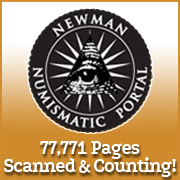
About UsThe Numismatic Bibliomania Society is a non-profit organization devoted to the study and enjoyment of numismatic literature. For more information please see our web site at coinbooks.org SubscriptionsThose wishing to become new E-Sylum subscribers (or wishing to Unsubscribe) can go to the following web page link MembershipThere is a membership application available on the web site Membership Application To join, print the application and return it with your check to the address printed on the application. Membership is only $20 to addresses in the U.S., $25 for First Class mail, and $30 elsewhere. For those without web access, write to: Terry White, Treasurer
AsylumFor Asylum mailing address changes and other membership questions, contact Terry at this email address: terrywhite5475@yahoo.com SubmissionsTo submit items for publication in The E-Sylum, just Reply to this message, or write to the Editor at this address: whomren@gmail.com BUY THE BOOK BEFORE THE COIN |
- WAYNE'S WORDS: THE E-SYLUM NOVEMBER 22, 2015
- ANS PARTNERS WITH THE NEWMAN NUMISMATIC PORTAL
- NEWMAN NUMISMATIC PORTAL SCANS B. G. JOHNSON INVOICES
- ANA ANNOUNCES DIGITAL ARCHIVE OF THE NUMISMATIST
- ANS LAUNCHES GREEK NUMISMATIC RESEARCH TOOL: PELLA
- NEW BOOK IN THE MONETA SERIES: #192
- BOOK REVIEW: AMERICAN GOLD AND SILVER
- BOOK REVIEW: MONUMENTS IN MINIATURE
- NOTES FROM E-SYLUM READERS: NOVEMBER 22, 2015
- THE NATIONAL HISTORICAL PARK SARATOGA QUARTER LAUNCH
- THE EMPIRE COIN COMPANY BUYS A LAKE
- LORRAINE PRATT IMMEN (1840-1927)
- WALTER BREEN AND COIN WORLD
- MORE ON ENGRAVED CONFEDERATE TREASURY SOUVENIR COINS
- BRYAN DOLLAR ENGRAVED FOLLOWING 1896 CONVENTION
- ARTICLE HIGHLIGHTS AIR-TITE COIN HOLDER COMPANY
- MORE ON THE 1848 REBUS PUZZLE MEDAL
- A HALF CENTURY OF MEDALLIC OBJECTS
- JULIAN'S SATIRICAL DEFENSE MEDAL
- QUERY: JOSEPH WHARTON MEDAL INFORMATION SOUGHT
- 'TOENAIL HOARD' OF 500 COIN CLIPPINGS FOUND
- DNW OFFERS WARD COLLECTION OF BRITISH TOKENS
- CELTIC COINS FROM THE GEOFF COTTAM COLLECTION
- SELECTIONS FROM THE SPINK ORDERS & DECORATIONS SALE
- SELECTIONS FROM THE HERITAGE WORLD CURRENCY SALE
- THE KWEICHOW BAMBOO DOLLAR
- THE LATVIA FIVE CATS FIVE EURO COIN
- THE SESTERTIUS OF AGRIPPINA SENIOR
- ROMAN COIN HOARD FOUND IN SWITZERLAND
- THE PURCHASING POWER OF ANCIENT COINS
- SOUTH FLORIDA ARTIST CONVICTED OF COUNTERFEITING
- MOY: BITCOIN ALLOWS MONEY TO BE PRIVATIZED
- BITWALKING DOLLARS: GET PAID TO WALK
- FEATURED WEB PAGE: WORLD COIN GALLERY
Click here to access the complete archive
To comment or submit articles, reply to whomren@gmail.com
WAYNE'S WORDS: THE E-SYLUM NOVEMBER 22, 2015

No email delivery issues were reported last week, so we'll revel in a brief respite from Comcast and other ISP problems.
New subscribers this week include: James C Britt, Harry M. Reichenberg, and Sam Winikor. Welcome aboard! We now have 1,896 subscribers.
This week we open with no less than three major announcements about numismatic literature digitization projects, one new online archive, a new book, and two book reviews.
Other topics include the Saratoga Quarter launch ceremony, engraved Confederate treasury coins, the Air-Tite Coin Holder company, coin clipping hoards, the Bamboo dollar, British tokens, Celtic coins, and world paper money.
To learn more about architecture on Roman coinage, the Macedonian kings, the 1844-O Proof Eagle, the 1952 British West Africa Sixpence, Dennis Tucker's visit to the Mint, Lake Empire, an engraved Bryan dollar, the purchasing power of ancient coins, and pieces de merde, read on. Have a great week, everyone!
Wayne Homren
Editor, The E-Sylum
ANS PARTNERS WITH THE NEWMAN NUMISMATIC PORTAL
The Newman Numismatic Portal and the American Numismatic Society (ANS) are pleased to announce a joint project that will greatly increase access to research materials in the field of American numismatics.
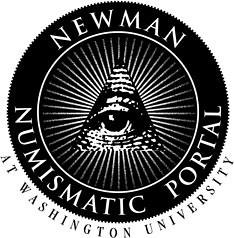 The Newman Portal, an online numismatic research resource administered through Washington University in St. Louis, has contracted with
Internet Archive to provide scanning services at the ANS Library. Internet Archive, a non-profit organization dedicated to digital preservation of
all media, will deliver scanning equipment to ANS and supply operational staff. The digitization effort will add content to both the Newman Portal
and the recently announced ANS Digital Library.
The Newman Portal, an online numismatic research resource administered through Washington University in St. Louis, has contracted with
Internet Archive to provide scanning services at the ANS Library. Internet Archive, a non-profit organization dedicated to digital preservation of
all media, will deliver scanning equipment to ANS and supply operational staff. The digitization effort will add content to both the Newman Portal
and the recently announced ANS Digital Library.
Ute Wartenberg Kagan, ANS executive director, commented “We are delighted to collaborate with the Newman Numismatic Portal on this digitization initiative, and the opportunity to scan rare or unique materials completely onsite is especially desirable.”
Chris Freeland, associate university librarian at Washington University, noted “The ANS is a natural partner for the Newman Numismatic Portal, and we are pleased to invest in the digitization of this important collection.” The scanning pipeline will focus primarily on the American portion of the ANS Library, beginning with the series of over 600 bound auction catalogs of the 19th and early 20th centuries.
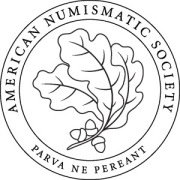 The ANS, established in New York City in 1858, houses the world’s most comprehensive numismatic library, numbering over 100,000 items. The
Newman Numismatic Portal, sponsored by a $2 million dollar grant from the Eric P. Newman Numismatic Education Society, began operations in December
2014. It has digitized over 1,000 documents to date, including a set of unique bid books from the firms of Samuel and Henry Chapman, which were
generously loaned by ANS trustee Dan Hamelberg.
The ANS, established in New York City in 1858, houses the world’s most comprehensive numismatic library, numbering over 100,000 items. The
Newman Numismatic Portal, sponsored by a $2 million dollar grant from the Eric P. Newman Numismatic Education Society, began operations in December
2014. It has digitized over 1,000 documents to date, including a set of unique bid books from the firms of Samuel and Henry Chapman, which were
generously loaned by ANS trustee Dan Hamelberg.
To read the complete article, see:
New Effort Provides Access to Numismatic
Materials (http://library-prod.wustl.edu/new-effort-provides-access-to-numismatic-materials/)

NEWMAN NUMISMATIC PORTAL SCANS B. G. JOHNSON INVOICES
The invoices of St. Louis dealer Burdette G. Johnson, covering the period from 1940 – 1947, are now available in the Newman Numismatic Portal collection on Internet Archive, at https://archive.org/details/bgj_invoices
The Johnson invoices consist of thousands of typescript pages and have been divided into individual correspondents by year. Represented among the thicker files are dealers such as Tom Elder (167 pages for 1942) and New Netherlands (122 pages for 1940). The files convey a sense of the rare coin trade in the 1940s. The largest dealers engaged substantial typing pools to prepare invoices, constantly shipped material on approval among themselves, and managed an extraordinary amount of manual accounting. The scope of the effort involved is readily apparent upon browsing these invoices.
 Before we had even announced the availability of the Johnson invoices on Internet Archive, eagle-eyed researcher Saul Teichman spotted an
invoice containing pedigree information on the 1844-O (unique proof) eagle. Johnson offered the coin to F.C.C. Boyd in 1940.
Before we had even announced the availability of the Johnson invoices on Internet Archive, eagle-eyed researcher Saul Teichman spotted an
invoice containing pedigree information on the 1844-O (unique proof) eagle. Johnson offered the coin to F.C.C. Boyd in 1940.
Most of the cataloging in the Johnson invoices is terse, but Johnson could not hold back on this piece. “1844 Perfect brilliant proof. This is not a coin with proof surfaces but an actual proof, as is shown by its entire appearance. I imagine it was struck at Philadelphia before the dies were sent to N.O. It is certainly a great rarity and in all likelihood entirely unique.” Johnson priced the coin at $225, about ten times the price of a “common” eagle.
We find also that in 1941 Johnson offered Hans Schulman a rare broadside copy of the Declaration of Independence, printed by order of the Rhode Island Assembly shortly after July 4th, 1776. Schulman apparently declined the offer, for Newman himself eventually acquired this document, as noted in the Harvard Library Bulletin (Vol. 3, No. 1, Winter 1949).
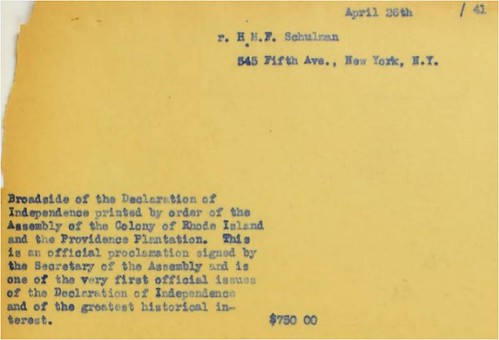
This broadside copy of the Declaration has recently been donated by the Newman family to Washington University in St. Louis as part of its Olin Library transformation. These are but two remarkable items from this rich archive, and we expect many more will be discovered as researchers become aware of this unique resource.
To read the 1844-O Proof Eagle invoice, see: https://archive.org/stream/fccboydinvoicesf1940john#page/n11/mode/1up
To view the Declaration broadside invoice, see: https://archive.org/stream/hmfschulmaninvoi1941john#page/n44/mode/1up
To read more on the Olin Library transformation, see: Reimagining Olin Library (http://news.wustl.edu/news/Pages/olin-library-transformation.aspx)
To browse the Johnson invoices, see:
Burdette G. Johnson Invoices (https://archive.org/details/bgj_invoices)
Saul Teichman adds:
I have been scanning through the various invoices. They list classic rarities, much on Gobrecht dollars and gold patterns and the occasional Indian and Lincoln cent in gold (struck on quarter eagle planchets). I sent the Mint State CC silver coinage information on to Rusty Goe.
In many cases you will see the same coin apparently being consigned to one dealer, then sent to another and so on, so users need to be careful when reading through these.
Invoices with RED or where items are noted as RED are Col. Green coins. Be careful not to confuse RED with RET (i.e. returned).
It is interesting to note coins that ended up in Eric Newman’s collection were offered for sale to others including the Newcomer-Green Continental dollars, the 1841 no drapery proof dime and others.
There are coins on the invoices including the Dewitt Smith-Brand Pacific Company $10 in gold which, not only did not sell at the time but ended up staying in the Brand family until sold in the Bower & Merena Brand II sale.
With regard to the 1822 Half Eagle, here are the entries I have found in the B.G. Johnson invoices. My guess is H.M.F. Schulman would have offered it to Farouk but, I guess, even he had limits !!
With regard to the invoices, I have looked at Boyd, Dr Judd, Kelly, Kosoff, Macallister, Mehl, Stacks, Schulman and maybe a handful of others related to pattern coinage.
The key is that a lot of these give the appearance of being approval invoices, with many items returned. Sometimes it is difficult to read the scribble on the pages to know what really happened.
One more thing people might find interesting is the prices and how collecting taste has changed.
For the most part, the pieces which really had the highest prices were the rare territorial gold pieces. Kohler ingots and the Pacific $10 were being priced in the same range as Brasher doubloons.
This was probably first noticed in Elder’s 1929? Lawrence sale when territorial pieces brought record prices.
Classic rarities of today, 1838-O half dollars, 1870-S dollars, 1875 $3, 1907 Ultra High Reliefs, 1913 nickels, 1884 and 1885 trade dollars, 1802 proof restrike dollars etc. were offered at fractions of the amounts these territorial pieces were being offered for.
Roger Burdette writes:
The Johnson-Newman business arrangement was simple and direct. There was no written contract.
After Newman's first purchase from the Estate he discussed the situation with Burdette G. Johnson, owner of St. Louis Coin and Stamp Co. At Johnson's suggestion he put up the money to buy items from the Green Estate. After purchase, Johnson would value all the coins [wholesale or retail – not sure which] and Newman could select whatever he wanted first. Then Johnson selected an equal value. They each owned their selections outright. Johnson would then sell the remainders and split the profit equally with Newman. Newman could then use his share of the profits to buy more coins from the Green Estate.
Items in RED on the invoices are ones where the profit was to be split. Johnson did all the selling, shipping, bookkeeping and other fulfillment activities. Selling expenses were deducted before the profits were divided.
Also, the Johnson invoices sometimes - not always - indicate returns or unsold pieces.
Many invoices to regular customers (Celinia Coin Co. for example) are really Johnson's guess about coins the customer might find desirable. That is, Celinia might call and say "We need a selection of early large cents." Johnson would reply with what amounts to an approval selection and an invoice.
All invoices were originally accompanied by adding machine tapes that Johnson used to confirm totals.
Dave Bowers adds:
One interesting aspect of provenances is that probably 75% or more of rarities sold from the 1950s through a generation ago were by private sale and never appeared in auction catalogs. For example, in 1961 Empire Coin Co. was the first to cross the $1 million sales/year mark, with lots of rarities, but no auctions. All of the 1,400 or so different patterns from the Lenox R. Lohr Collection were sold by private treaty. Ditto for most of the ex Farouk patterns brought back from Cairo in 1954 by Sol Kaplan and Abe Kosoff (I was the main buyer of those, working hard to turn them over quickly to preserve my capital).
Today this non-auction-appearance situation is best appreciated in certain provenances of large copper cents passing privately from one person to another.
THE BOOK BAZARRE
ANA ANNOUNCES DIGITAL ARCHIVE OF THE NUMISMATIST

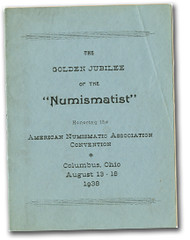 The American Numismatic Association is excited to announce its digital archives of all 127 volumes of its flagship publication,
The Numismatist. Beginning December 1, ANA members can access every issue of the magazine, from 1888 to the present.
The American Numismatic Association is excited to announce its digital archives of all 127 volumes of its flagship publication,
The Numismatist. Beginning December 1, ANA members can access every issue of the magazine, from 1888 to the present.
No matter if you are a coin collector studying a recent purchase, a numismatic auction house researching an upcoming catalog, or a student writing a paper on world currencies and economies, The Numismatist is a trusted repository of classic articles and hidden gems on all things money.
 Helpful search features guide you to the information you seek, including relevant links to useful resources, an easily accessible table of
contents, and indices with live links.
Helpful search features guide you to the information you seek, including relevant links to useful resources, an easily accessible table of
contents, and indices with live links.
The online editions look exactly like the printed originals, allowing you to experience The Numismatist in its historical context—something the average website can’t offer. Each archived page can be downloaded and printed, as well as bookmarked, cited and referenced by other registered users.
The ANA’s digital archives of The Numismatist is your one-stop hobby reference, helping you expand your knowledge base as you explore the world of numismatics.

To read the complete article, see:
https://www.money.org/the-numismatist-digital-archives
ANS LAUNCHES GREEK NUMISMATIC RESEARCH TOOL: PELLA
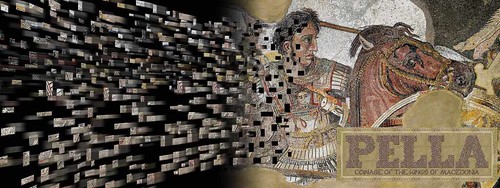
The American Numismatic Society (ANS) is excited to announce the launch of its latest digital platform, PELLA (numismatics.org/pella/), an important new research tool for ancient Greek numismatics that provides a comprehensive, easily accessible online catalogue of the coinage produced by the kings of the Macedonian Argead dynasty (c.700–310 BC). Cataloguing the individual coin types of the kings from Alexander I (ruled 498–454 BC), the first of the Macedonian kings to strike coins, down to Philip III Arrhidaeus (ruled 323–317 BC), PELLA allows users to conduct research on specific types, view examples from multiple collections, conduct statistical analyses of weight and other measurement data, and see maps of where the type was minted and where examples have been found in hoards.
As a linked data project, PELLA connects to the relevant pages within the ANS's collection website, MANTIS (numismatics.org/search/), as well as Inventory of Greek Coin Hoards Online (coinhoards.org), and incorporates material from other public collections. The current version of PELLA provides links to examples of the coinage (in the name) of Alexander the Great and Philip III Arrhidaeus present in the ANS collection, the Münzkabinett of the State Museums of Berlin, and the British Museum totaling nearly 10,000 examples of individual coins. The current version of PELLA uses the numbering system and typology originally created and published by Martin Price in The Coinage in the Name of Alexander the Great and Philip Arhidaeus, London 1991, with the addition of modifications that greatly enhance the volume’s usefulness as an online resource.
PELLA is made possible by stable numismatic identifiers and linked open data methodologies established by the Nomisma.org project. Coin type data are made available with an Open Database License.
Dr. Peter van Alfen, Margaret Thompson Associate Curator of Greek Coins, commented on the announcement. "The Macedonian kings of the Argead dynasty struck arguably the most influential coinages of the ancient Greek world, so it’s appropriate that our first digital project in Greek numismatics focuses on their coinage. We also wanted to provide a specific platform for facilitating research on their coinages, particularly since the ANS holds one of the largest and most important collections of Argead coinage in the world. By being able to link to other important collections, the research potential is significantly enhanced. The ANS is committed to enhancing its online presence and digitizing its collection - PELLA is another example of our progress, and we are proud it well help educate those with general numismatic interest as well as academic researchers.”
The American Numismatic Society, organized in 1858 and incorporated in 1865 in New York State, operates as a research museum under Section 501(c)(3) of the Internal Revenue Code and is recognized as a publicly supported organization under section 170(b)(1)(A)(vi) as confirmed on November 1, 1970.
To read the complete press release, see:
The American Numismatic Society Announces the Launch of PELLA
(http://numismatics.org/NewsEvents/PELLA)
NEW BOOK IN THE MONETA SERIES: #192
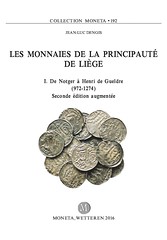
Moneta # 192, J.-L. Dengis, Les monnaies de la principauté de Liège, I. De Notger à Henri de Gueldre (972-1274), Collection Moneta, 192, Wetteren, 2016, 390 p., 10 pl. dessins, 11 pl. ISBN 978-94-91384-60-8
For more information, or to order, see:
Les monnaies de la Principauté de Liège (www.moneta.be/volumes/moneta_192.htm)
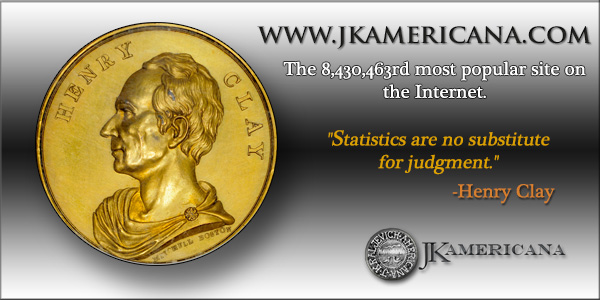
BOOK REVIEW: AMERICAN GOLD AND SILVER
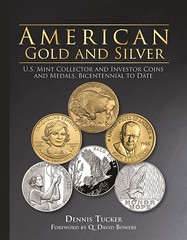 Imagine if a coin collector had visited the Philadelphia Mint in the 1790s and had seen engraver Robert Scot working on dies, had watched
copper, silver, and gold coins being struck on presses, had seen newly minted “pennies” packed in wooden casks and shipped by horse wagon, and had
taken notes and asked questions. How much more we would know now!
Imagine if a coin collector had visited the Philadelphia Mint in the 1790s and had seen engraver Robert Scot working on dies, had watched
copper, silver, and gold coins being struck on presses, had seen newly minted “pennies” packed in wooden casks and shipped by horse wagon, and had
taken notes and asked questions. How much more we would know now!
A new Whitman Publishing book, American Gold and Silver, reflects the work of a modern-day equivalent of that fictitious visitor. Author Dennis Tucker, through the office of Mint Director of Corporate Communications Tom Jurkowsky and his staff, has had the opportunity in recent years to visit and go behind the scenes at all four operating mints: Philadelphia, Denver, San Francisco, and West Point.
I had the honor of accompanying him, Tom, and on occasion some other researchers. At the Philadelphia Mint Dennis visited with the artist-sculptors in the Engraving Department, viewed sketches and models, and learned many details of their work. At West Point he saw gold bullion-related coins being struck. Examining coinage dies under microscopes, witnessing a huge Gräbener press stamping out five-ounce silver discs, watching limited-edition collector coins being carefully packaged, observing circulation coins being put in huge sacks and handled by forklifts—Dennis experienced it all.
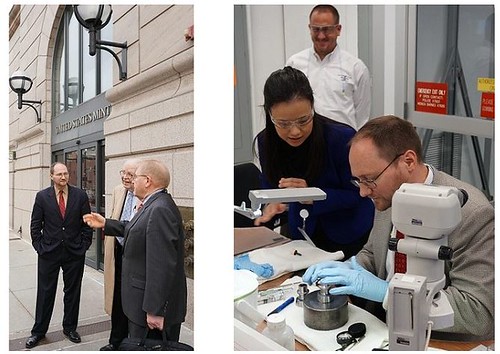
Dennis Tucker, Q. David Bowers, and Tom Jurkowsky at the Denver Mint (left);
Tucker examining a John F. Kennedy Presidential dollar coinage die at the San Francisco Mint (right).
The result is a numismatic study, a tour de force, and for you the reader an “I was there” experience. Deputy Mint Director Dick Peterson shared information, as did the superintendents (today called plant managers) of Philadelphia, Denver, San Francisco, and West Point, and mint employees involved in all aspects from planchet preparation to coinage to shipping. This level of first-person experience is at once exciting, informative, and in the annals of numismatic research unique.
While we know much about how copper, silver, and gold coins were made at the Philadelphia Mint in the 1790s, much more about that era is still conjecture. There was no Dennis Tucker present. So far as I have been able to determine, no dedicated researcher or journalist ever visited to take detailed notes.
Today the U.S. Mint—the Treasury agency headquartered in Washington, DC—is the center for supervising the nation’s four mint facilities plus the Fort Knox bullion depository, keeping records, implementing coin programs (with themes mandated by Congress), releasing news to keep the public informed, and many other activities. The Mint often has displays at leading coin conventions, where officials and employees are on hand to meet and greet visitors. It is a new era of information and communication.
The above said, American Gold and Silver is the first book in numismatics to have been produced with the collaboration of those actively involved, day to day, in American coinage—artists, assayers, historians, factory workers, technicians, managers, and other Mint staff and workers.
In my own world of research, writing, buying, and selling, I concentrate mainly on older coins (although I do have a collection of modern dollars). As I read the advance proofs of this book I learned many things that for me were new and even amazing. I was quite surprised to learn that one of the First Spouse gold coins, a series honoring presidential wives, depicts and names a lady who, for all I know, was never in the White House! In fact, her cause was anathema to President Woodrow Wilson, who might have had her tossed in jail (as he did with others of her persuasion). Her name is Alice Paul. (If you can’t wait, fast-forward to chapter 6.)
Much other information—some familiar, some new—awaits you, compiled, distilled, and analyzed in American Gold and Silver. Beyond the interesting text the book will serve permanently as the source for facts on the U.S. Mint’s modern gold and silver coins and medals.
Enjoy the experience!


To read the complete article, see:
Behind the Scenes at the U.S. Mint: “You Are
There!” (http://news.coinupdate.com/behind-the-scenes-at-the-u-s-mint-you-are-there/)
BOOK REVIEW: MONUMENTS IN MINIATURE
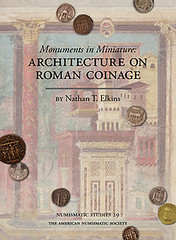 The American Numismatic Society is pleased to announce the publication of Monuments in Miniature: Architecture on Roman Coinage, a
new book by Nathan T. Elkins that recasts the scholarship on this popular subject. Rather than focusing on the iconography, Elkins study seeks to
contextualize these coins and understand the broader social and cultural context that informed these architectural representations.
The American Numismatic Society is pleased to announce the publication of Monuments in Miniature: Architecture on Roman Coinage, a
new book by Nathan T. Elkins that recasts the scholarship on this popular subject. Rather than focusing on the iconography, Elkins study seeks to
contextualize these coins and understand the broader social and cultural context that informed these architectural representations.
Although the emphasis is on Roman coinage, earlier Greek types are also featured for comparative analysis, including this sixth century BC silver stater of Zancle that shows harbor buildings on a sandbar encircling a dolphin.

In the Persian empire, city walls were a traditional symbol of power that were often represented on the coinage produced by the satrapies of Cilicia and Phoenicia. A particularly fine example of this tradition is this mid-fourth century BC tetradrachm of Tarsus, which depicts a lion attacking a bull above two rows of turreted walls.

The volume features over two hundred images and provides a comprehensive catalogue of Roman architectural coin types organized into Early, Late, and Provincial sections. I don’t want to step on Elkins’ detailed analyses here, but I do want to highlight one of the more spectacular coins, a cistophorus of Augustus from the mint at Pergamon that depicts the Temple of Mars Ultor on the Capitoline Hill in Rome.

As Elkins indicates, this particular representation likely bore no resemblance to the actual structure, which some historians argue was never actually built. Still, it is a lovely example of numismatic art!
The regular representation of the built environment on coins was a purely Roman phenomenon among the ancients. In the Greek world, architectural representation on coinage was very uncommon; when it did appear it referred directly to the local identity of the issuing state. Coins of the Persian satrapies only rarely depicted fortifications in conjunction with traditional Persian emblems of royalty, power, and shrines of the chief deities in the minting city. The Roman use of the iconography of building was fundamentally different. From the first occurrence in 135 BC through the late Roman Empire, the architectural images on coins from Rome commemorated or politicized the monument in question. By the mid-first century BC and into the Imperial period, architecture had become commonplace in the repertoire of Roman coin iconography.
The representation of monuments is one of the most beloved (and belabored) topics in studies of Roman coin iconography. It is also a theme in dire need of re-exploration.
Why was Rome the only ancient civilization to depict man-made monuments habitually on its coinage? Why did Greek urban centers with marble-clad monuments and politically charged building programs feature their great monuments on coins only after Roman domination? What social and cultural developments prompted Roman moneyers in the late second and first centuries BC to depict buildings on coins for the first time? What circumstances led to a lower frequency of architectural coin types in the third and fourth centuries AD until they ultimately disappeared from the Roman coinage in the fifth century? And why were these late Roman depictions more symbolic in their lack of reference to specific constructions? These are questions to be explored. This book departs from the treatment of the images as sources for the appearance of ancient monuments. Instead it explores the historical, artistic, social, and cultural contexts of the iconography of building on Roman coins from its emergence in the late second century BC to its disappearance in the fifth century AD.
For more information, or to purchase, see:
http://numismatics.org/Store/Monumentsinminiature
To read the earlier E-Sylum article, see:
NEW BOOKS FROM THE AMERICAN NUMISMATIC SOCIETY
(www.coinbooks.org/esylum_v18n42a06.html)
NOTES FROM E-SYLUM READERS: NOVEMBER 22, 2015
On Collectors and Collecting
Martin Kaplan writes:
l especially liked your comments about collectors and collecting.
To read the earlier E-Sylum article, see:
WAYNE'S NUMISMATIC DIARY: NOVEMBER 15, 2015 : What Is a Collector?
(www.coinbooks.org/esylum_v18n46a22.html)
The Savings Bank of Louisville, KY
Regarding the obsolete banknote discussed in Caitlyn Trautwein's article, Dennis Schafluetzel writes:
The Savings Bank of Louisville, KY is listed in Paul Garland’s book “The History of Early Tennessee Banks and Their Issues” under Nashville, TN G-970 – G-974. Garland indicates Otis Anolo & Co. were Agents. In existence in 1837 and 1838. No listing in Haxby since it was not an authorized Bank in TN. Garland also lists a number of Otis Anolo & Co. (pre-denominated checks) on the Planters Bank of TN from this hard times period (G-975 – G-980). They signed and issued checks of denominations of: 12 ½ , 25, 50 cents, 2 types of both $1 and $2 checks. The 12 ½ cent check has been discovered since Paul Garland book was published.
To read the earlier E-Sylum article, see:
SLEUTHING OBSOLETE CURRENCY SECRETS
(www.coinbooks.org/esylum_v18n46a15.html)
Query: NASCA Wayte Raymond Part 2 Catalog Sought
Michael Atkins (matkins2@comcast.net) writes:
Would anyone happen to have a copy of NASCA’s May 1978 Wayte Raymond Sale, Part 2? I am trying to find the descriptions of four medals from that sale: lots 3612, 1788, 2910 and 2522. That catalog seems excessively hard to track down.
Another 1952 British West Africa Six Pence
New subscriber Harry M. Reichenberg writes:
While doing some research on the 1952 British West Africa sixpence, I came across the article submitted by Mr. John Linhoss in The E-Sylum: Volume 16, Number 35, August 25, 2013, Article 19. If I may, I would like to add a little bit to the story.
I am thinking of moving from the west coast to the east coast, where I lived many decades ago, and was rummaging around to see what can be discarded. I came across a box of British West Africa coins which included the subject coin in what I would call uncirculated condition. A friend of mine, his name was Charles, I don't remember his last name, knew I collected coins and so he gave me some of these coins. I'm not familiar with the other names that were mentioned in the article. At that time I was getting away from foreign coins and concentrating on US coins. So I just put them aside and forgot about them.
I would appreciate hearing about this coin if you have any further information.
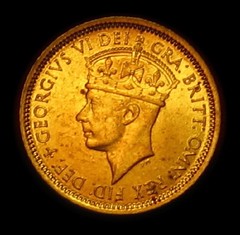

To read the earlier E-Sylum article, see:
THE 1952 BRITISH WEST AFRICA SIX PENCE
(www.coinbooks.org/esylum_v16n35a19.html)
The Museum of the American Revolution
Kay Olson Freeman writes:
Here is announcement of a new children’s book about Adam Eckfeldt. It comes from the weekly newsletter of Museum of American Revolution which is being built now in Philadelphia.
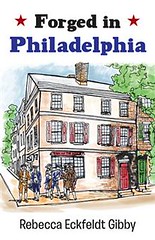 "Adam made his way from the forge and through the shop, which was empty at this hour of the day. The shop was a small wooden structure
between the forge and the house. Customers could enter through a door that opened onto Fifth Street. A large sign that read "The Sign of the
Sickle" was nailed over the door. Inside was a broad, plank counter covered with household items left for repair. Wooden shelves on all four
walls of the shop were filled with metal rings for wheels, staves to form barrels, and boxes of fireplace tools, pots, pans, nails, hinges, and
latches of all sizes."
"Adam made his way from the forge and through the shop, which was empty at this hour of the day. The shop was a small wooden structure
between the forge and the house. Customers could enter through a door that opened onto Fifth Street. A large sign that read "The Sign of the
Sickle" was nailed over the door. Inside was a broad, plank counter covered with household items left for repair. Wooden shelves on all four
walls of the shop were filled with metal rings for wheels, staves to form barrels, and boxes of fireplace tools, pots, pans, nails, hinges, and
latches of all sizes."
"Adam worked at the blacksmith business his father, Jacob, had started upon arriving in Philadelphia in 1764. It was a growing business in a flourishing city. Now it was 1792, and the War of Independence from England had been won. Philadelphia was the capital of the government, culture, and commerce in the newly formed United States."
"Adam waited impatiently at the corner of Sixth and Cherry streets. The new mint building at Seventh and Farmer's Ally was not yet complete. An old distillery that once belonged to Michael Shubert had been purchased for use by the mint. The stillhouse had to be first dismantled and removed before the cornerstone of the mint could be laid. In the meantime, David Rittenhouse had commandeered a small machine shop owned by saw-maker John Harper to assemble the presses and castings necessary for coin production."
To read the complete article, see:
Forged in Philadelphia
To read the earlier E-Sylum articles, see:
NEW BOOK: FORGED IN PHILADELPHIA (www.coinbooks.org/esylum_v17n12a06.html)
BOOK REVIEW: FORGED IN PHILADELPHIA
(www.coinbooks.org/esylum_v17n47a08.html)
THE BOOK BAZARRE
THE NATIONAL HISTORICAL PARK SARATOGA QUARTER LAUNCH
 U.S. Mint official Ron Harrigal presented Bracewell with a framed set of Saratoga quarters, one each from the Philadelphia and Denver
mints. Together, they took part in a commemorative “coin pour,” dumping hundreds of the new quarters into a black metal pot on the high school
auditorium’s stage. Free quarters were given to all Schuylerville students 18 and under.
U.S. Mint official Ron Harrigal presented Bracewell with a framed set of Saratoga quarters, one each from the Philadelphia and Denver
mints. Together, they took part in a commemorative “coin pour,” dumping hundreds of the new quarters into a black metal pot on the high school
auditorium’s stage. Free quarters were given to all Schuylerville students 18 and under.
Fox told The Saratogian how the latest coin is one of 17 she has designed for the U.S. Mint, including two more for the America the Beautiful series, which show Glacier and Acadia national parks in Montana and Maine, respectively.
“I wish I’d been chosen for the Hawaii coin,” she told the newspaper. “I’d love to go there.”
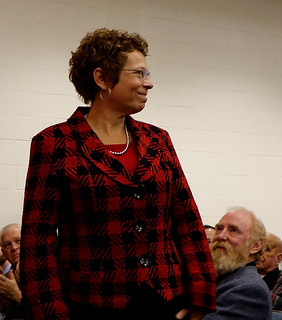 Hundreds of schoolchildren were on hand, with several of them participating in the ceremony which was live-streamed to the public.
Additional event participants included Mint Artistic Infusion Program artist Barbara Fox, designer of the coin's reverse; Saratoga National
Historical Park Superintendent Amy Bracewell; Park Ranger and Historian Eric Schnitzer; and Matt Scollin, regional director for U.S. Representative
Elise Stefanik.
Hundreds of schoolchildren were on hand, with several of them participating in the ceremony which was live-streamed to the public.
Additional event participants included Mint Artistic Infusion Program artist Barbara Fox, designer of the coin's reverse; Saratoga National
Historical Park Superintendent Amy Bracewell; Park Ranger and Historian Eric Schnitzer; and Matt Scollin, regional director for U.S. Representative
Elise Stefanik.
Event attendees were among the first in the Nation to get newly minted Saratoga National Historical Park quarters during the coin exchange held after the ceremony. Collectible bags and rolls of circulating quality Saratoga National Historical Park quarters will be available for purchase from the Mint starting on Nov. 30 at noon Eastern Time.
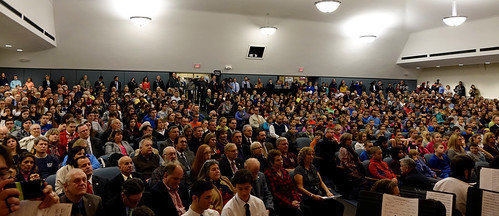
Saratoga quarter launch audience
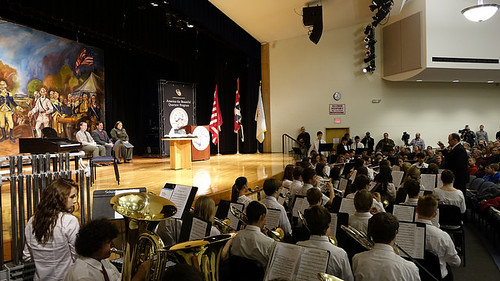
Saratoga quarter launch stage
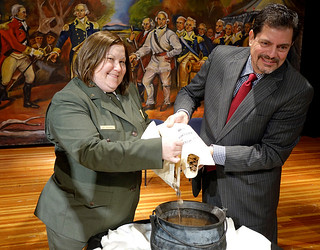
Saratoga National Historical Park Superintendent Amy Bracewell
and United States Mint Acting Quality Manager Ron Harrigal
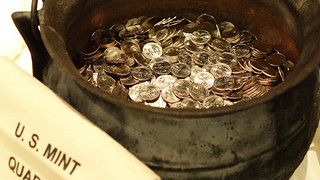
Saratoga quarter coin bucket
To read the complete article, see:
State and Union: Little Valley artist's coin design released this week
(www.oleantimesherald.com/news/state-and-union-little-valley-artist-s-coin-design-released/article_18262b0e-8e7c-11e5-aee6-93e3952ba7ca.html)
To read the complete U.S. Mint press release, see: United States Mint Launches Saratoga National Historical Park Quarter (www.usmint.gov/pressroom/?action=press_release&id=1730)
To view the Mint's Saratoga Quarter launch photo archive, see: Saratoga National Historical Park quart...
(www.flickr.com/photos/129211989@N07/sets/
72157660587680578/with/22698049748/)
To read the earlier E-Sylum article, see:
ARTICLE FEATURES SARATOGA QUARTER DESIGNER BARBARA FOX
(www.coinbooks.org/esylum_v18n45a14.html)
THE EMPIRE COIN COMPANY BUYS A LAKE
 American Numismatic Society Francis D. Campbell Librarian David Hill writes:
American Numismatic Society Francis D. Campbell Librarian David Hill writes:
If I stopped to read everything interesting I encountered in the course of a day I wouldn’t get anything done, but this small item from Coin World, August 4, 1961, really caught my eye. It truly was the golden era of coin collecting, when a small firm like Q. David Bowers’ and James Ruddy’s Empire Coin Company could buy its own lake for the private use of its employees!
Dave Bowers writes:
In 1961, we learned that one of the largest privately-owned lakes in the region, near a place called Newark Valley, as part of a 212-acre preserve was available, Phantom Lake it was called, with its own beach and swimming area, with forest surrounding. We bought this, and named it Lake Empire. We built a pavilion in addition to a two-story house that was already there, and made it available to our employees and friends for their recreational enjoyment. This was a bright idea. Later, it was sold to the State University of New York (SUNY Binghamton), and used as a similar facility for college students. The name was retained.
I always felt that our business success should be shared with employees. It was company policy to suggest that when we attended conventions in distant cities those inclined should go a day earlier or stay a day later to visit museums, tourist attractions, and other things of interest. It was also policy to have all employees sign in for the same hotels and restaurants, the last often the best in town, that we did.

Aerial view of part of Lake Empire owned by Empire Coin Company in the 1960s. (Binghamton Evening Press)
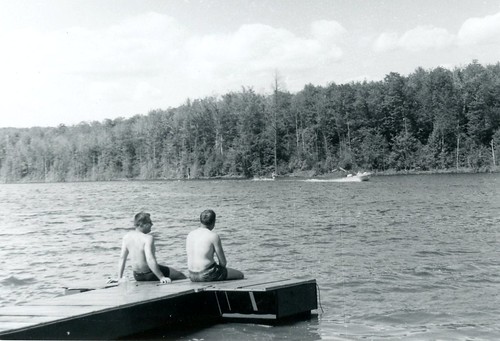
Jim Ruddy (left) and Dave Bowers look over the expanse of water.

Hank Spangenberger as lifeguard with some
Empire staff members on a dock in July 1963,
Dave adds:
On the other hand a not-so-bright idea was when Jim and I learned that a local company, Creative Printing, was for sale. As we were turning out catalogs, coin-premium guides, and other things, this seemed be a great idea! It proved to be analogous to buying a herd of cows instead of buying milk at the grocery store. IBM, General Electric, and some other local businesses were clients, not in a major way, but because they liked to spread their printing contracts around. We bought another printing press and made some improvements, but to little avail, as we soon learned that margins in the printing business were nothing like those in rare coins. We gave up the effort and sold it at a loss.

LORRAINE PRATT IMMEN (1840-1927)
Lorraine Pratt Immen (1840-1927), a native of Michigan lived there as a lifelong resident. In 1865, she married Frederick Immen (1837-1909) an immigrant from Depstadt, Bavaria, Germany, a wealthy carpet dealer. They lived at 35 West Lafayette Street, Grand Rapids, Michigan and had two children Elmer (1862-) and Arthur B. (1867-). Their home was an elaborate mansion that served for many social gatherings and various women's clubs gathering in the great ballroom.
She was a very active traveler, writer, collector of books, art, curiosities and coins, and was very involved in the arts and society. In 1887, she was the Founder of the Shakespeariana Club of Grand Rapids. She was also a member of the Michigan Historical Society, the Ladies Literary Club, and the vice-president of the Michigan Association of Elocutionists. Her collection of books, art, antiques, documents, photographs, correspondence, clippings, etc. are kept in the Grand Rapids Public Library.
Her curiosity about a Fugio in her possession caused her to contact the Chapmans. She obviously had no knowledge of American Colonial coins and so she wrote to Samuel Hudson and Henry Chapman with a very eager to learn mind. Her drawings of the Fugio are as amusing and entertaining as her descriptions and her letter.
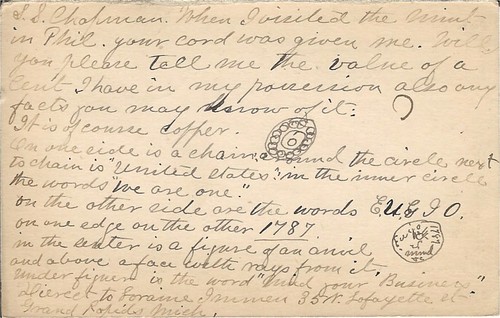
“I visited the Mint in Phil. your card was given me. Will you please tell me the value of a Cent I have in my possession also any facts you may know of it. It is of course copper. On one side is a chain and the circle next to the chain is “United States” in the inner circle the words “We are One” on the other side are the words EUGIO on the edge on the other 1787 on the center is a figure of an anvil and above of a face with rays from it Under figure is the word “Mind Your Business”
Direct to Lorraine Immen, 35 West Lafayette Street, Grand Rapids, Mich.”
In 1895 she was a charter member of the Michigan State Federation of Women’s Clubs. In 1896 she published a booklet, California, giving details of her travels there and the impressions they gave, which were originally published as Letters of Travel in California that ran in the Grand Rapids Herald.
Her picture appeared on the front page of the Grand Rapids Herald, Sunday, July 23, 1899.
In 1900, she donated fifty books to the new library of the women’s building of the Michigan State Agricultural College.
Her husband died April 9, 1909 at Washington, D.C., and is buried in Oakhill Cemetery, Grand Rapids, Michigan.
She died October 20, 1927 and is buried at Oakhill Cemetery, Grand Rapids, Michigan.
To read the complete article, see:
IMMEN,
LORRAINE PRATT
(https://sites.google.com/site/numismaticmallcom/encyclopedic-dictionary-of-numismatic-biographies/immen-lorraine-pratt)
WALTER BREEN AND COIN WORLD
Mention of the late Walter Breen can still stir up flaming passions. I recall learning in 1974 that at Coin World, Breen did not exist and would never exist again! I had written a review of a reprint of Dr. Maris' work on New Jersey Coppers, a book made worthwhile mostly by Breen's in-depth introduction to the series. My typed review copy came back to my desk attached to the publisher's son-in-law, who sternly informed me, "Walter Breen does not exist at Coin World!!!"
A few years later the late Dr. Stanley Apfelbaum of First Coinvestors arrived with legal staff to inform the publisher, "I own Breen. I am going to merchandise him to the hilt, and exclusion of his name from our ads will be regarded as an unfriendly act! These are my lawyers!!!" Breen immediately returned from the dead!
This excommunication dated back several years to Breen's former Coin World column "Bristles and Barbs" which examined the controversial origins of many classic U.S. rarities. Breen was fascinated by such old numismatic expressions such as piece de Plaisir and piece de caprice that described many side-door Mint productions. One fine day in silly season when the only CW staffer with language skills was on vacation, Walter described a famous rarity as piece de merde, piece of S--t! This description got through and was duly received by thousands of readers. The merdt hit the fan - no more Breen until Apfelbaum's threats.
To read the earlier E-Sylum articles, see:
CONFRONTING THE LEGACY OF WALTER BREEN
(www.coinbooks.org/esylum_v18n45a11.html)
READER COMMENTS ON WALTER BREEN (www.coinbooks.org/esylum_v18n46a10.html)
THE BOOK BAZARRE
MORE ON ENGRAVED CONFEDERATE TREASURY SOUVENIR COINS
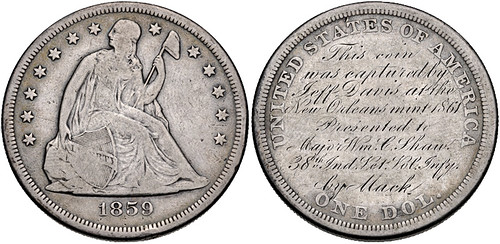
Kerry Wetterstrom of Classical Numismatic Group, Inc. writes:
A point of correction on Alan Weinberg’s note on the engraved 1861 presentation piece we sold last week. I’m not certain where the price realized figure of $4600 comes from, or that the buyer was an “East coast dealer.” The coin realized $7500 plus the 15% buyer’s fee, and was sold to a collector. There was a flurry of bidding on the piece during the last minute, and after one bidder submitted a bid of $7117, the successful buyer won the lot for $7500, reduced from a substantially higher bid. Truly astounding!
All three of the “final” bidders placed their bids at “Nov 11, 2015 at 12:34:15 p.m. ET,” which was literally during the last seconds the computer and site would recognize a bid. Pretty amazing how much interest this coin generated, and the publicity E-Sylum gave us certainly was a major factor!
Paul Hybert writes:
George B. McClelland resigned from the army in November 1864, so I do not see how he would have been part of the Union Army, in the field, in April 1865. (I do not know McClelland's exact whereabouts in April 1865, but consider North Carolina unlikely.) Perhaps a search of military rolls would turn up other officers with a name starting with Mc (or Mac).
Michael T. Shutterly writes:
I enjoyed Alan V. Weinberg’s explanation of the background of the “Engraved Confederate Treasury Souvenir Coins,” but I do not believe that his supposition that “The ‘Mack’ referred to on the CNG piece is most definitely General George McClellan who was known as ‘Little Mac’ due to his very short stature. Due to the status of the Indiana Major, it is possible that Gen'l McClellan may have selected this coin out of the surrendered Treasury and given it to the Major as a souvenir, who had it so engraved afterward. Or, even more likely, that McClellan invited or permitted Union high-ranking officers to select coins out of the Confederate Treasury as souvenirs, thus ‘presenting’ them to the officers, There are a sufficient number of these ‘Confederate’ engraved coins extant to indicate McClellan did in fact know of and approved of the selection and engraving practice.”
Although McClellan remained on the official U.S. Army rolls until he formally resigned his commission at the time of the 1864 Presidential election (when he ran as the Democratic candidate against Lincoln), he had no active involvement in the Army or in fighting the Civil War after Antietam (or Sharpsburg) in September 1862. He most definitely had no part in the capture of whatever remained of the Confederate Treasury in the Spring of 1865, and would not have been in a position to “present” any items to any Union officers.
Alan is probably correct in his description of how these “souvenir coins” came to be, I just think he has the wrong “Mack”.
Mark Hotz writes:
I read with interest Alan Weinberg's comments on the 1859 Silver Dollar "pocket piece" that had been in CNG's recent sale and featured in the November 1, 2015, E-Sylum.
It is interesting to learn that there are other such pieces that seem to have been part of the remaining Confederate Treasury funds surrendered at Greensboro, NC.
However, I have to disagree with several of Alan's assertions. First and foremost, he claims that the "Mack" engraved on the CNG 1859 dollar is "most definitely" General George B. McClellan. He also goes on to suggest that McClellan "selected this coin out of the surrendered Treasury and given it to the Major as a souvenir." He then suggests that "even more likely" McClellan invited or permitted Union high-ranking officers to select coins out of the Confederate Treasury as souvenirs...."
It is virtually certain that the "Mack" referred to on the CNG 1859 dollar was NOT General George B. McClellan. It is hard for me to understand how Alan could surmise this, other than wishful thinking. McClellan ran for president against Abraham Lincoln in 1864. After he lost the election, he resigned from the army; Lincoln accepted his resignation without comment, and disillusioned, McClellan and his family sailed for Europe on 25 January 1865 for a self-imposed exile, not returning until 1868.
Accordingly, McClellan was not in the United States in April of 1865 for the surrender of the Confederate Treasury, would have had no role in disbursal of any of the funds, and was not even a commissioned officer in the US Army at that time.
Additionally, I have a problem with just dismissing the convoluted engraving on the CNG 1859 dollar as "mangled". My reading is that the coin itself was captured by the Confederacy - personified by Jefferson Davis - when the Confederates seized the New Orleans Mint in 1861. As Alan does state, it then became part of the remaining Confederate Treasury, and was presented to the Indiana officer.
Weinberg's own 1859 dollar is far more interesting in that it provides a place and date. It notes that the coin was given by Jefferson Davis at Greensboro NC on April 26, 1865. Jefferson Davis, of course, was not at Greensboro at that time. So the comment must refer to the coin being "taken" from what was left of the Confederacy - personified as Jefferson Davis, as with the CNG dollar - rather than from Davis himself."
Dave Ginsburg offers these thoughts:
I was rather confused by several of the assertions that Alan Weinberg made regarding the engraved 1859 Liberty Seated dollar in last week’s issue.
While we’ll never know if the coin was carried as a pocket piece, it appears unlikely that war-time circulation wear would have affected the engraving, since Major Shaw apparently wasn’t promoted to that rank until June 8, 1865, according to an informal, although fairly detailed, biography on the “FindAGrave” website.
By the way, the regimental history of the 38th Indiana to which the “FindAGrave” entry refers is contained on pages 311-345 of Volume II of Indiana’s Roll of Honor by Theodore T. Scribner (published by A.D. Streight, Indianapolis, 1866), which is available via HatiTrust.
While Major Shaw appears to have been an able soldier, having been elected sergeant when the regiment was formed in September 1861 and subsequently promoted four times (to second lieutenant, first lieutenant, captain and finally, major) between September 1864 and June 1865, I don’t see anything in his record to suggest that he would have been known to Major General George McClellan, especially since Gen. McClellan commanded the Army of the Potomac in the East (Virginia and Maryland, mostly) and the 38th Indiana fought in the West (Tennessee and Georgia, mostly).
In any event, according to the rather detailed article on Wikipedia (not a perfect source, I know, but one that is easily available), Gen. McClellan was removed from command of the Army of the Potomac in November 1862 and exiled to New Jersey, where he remained for the rest of the War, although he did not resign his commission until Election Day in November 1864. Following his defeat in the presidential election, he and his family left for what turned into a three-year stay in Europe. The New York Times reported that he and his family sailed on January 25, 1865.
As a result, Gen. McClellan wasn’t in the country when the Confederate Treasury was captured in May 1865, so I don’t see how he could have selected any coins for presentation.
Regarding the “Mack” who presented the coin, while I don’t know enough about Gen. McClellan to know if he regarded his nickname of “Little Mac” favorably, I suggest that anyone to whom the General would have presented such a coin would have referred to him as “Little Mac” and not “Mack.”
I also believe that if the coin had been part of the Confederate Treasury, this more recent (at the time) event would have been mentioned in the inscription, rather than the reference to New Orleans. Certainly, since the 38th Indiana was in North Carolina at the end of the war, Major Shaw could have known someone who participated in the capture of the Confederate Treasury.
As for the coin itself, I suggest that the most likely explanation is that the coin is what it says it is: a coin that was seized by the Confederacy from the New Orleans Mint in early 1861 and subsequently recaptured by Union troops following the fall of the City in April 1862. I have studied this period a little bit and there was a great game of “hide and seek” that went on among Confederate officials and sympathizers, Union officials and New Orleans bankers involving the specie that remained in and near New Orleans after the Union recapture of the City.
Regarding the coin’s reference to “Jeff Davis”, I suggest that his name is used as a metonym for the Confederacy (much as we refer to “Wall Street” when we mean the finance industry).
Of course, my explanation leaves open the question of exactly when Major Shaw received the coin and from whom. I suggest it is likely he received the coin after the War, sometime after he returned home to Indiana and that it was given to him by a friend who had served in Louisiana. Otherwise, I see no obvious connection between Major Shaw and New Orleans.
If Mr. Weinberg or anyone else has documentation that illuminates the coin’s history, I would certainly like to see it.
To read the “FindAGrave” entry for Major Shaw, see: http://www.findagrave.com/cgi-bin/fg.cgi?page=gr&GRid=55916833
To read Indiana’s Roll of Honor Vol. II, see: http://babel.hathitrust.org/cgi/pt?id=nyp.33433081798765;view=1up;seq=13
To read the Wikipedia entry for Gen. McClellan, see: https://en.wikipedia.org/wiki/George_B._McClellan
To read The New York Times article discussing the McClellan’s departure (which is behind a subscriber paywall), see: http://www.nytimes.com/1865/01/26/news/local-intelligence-departure-gen-mcclellan-for-europe-his-reception-board.html
To read the earlier E-Sylum article, see:
ENGRAVED CONFEDERATE TREASURY SOUVENIR COINS
(www.coinbooks.org/esylum_v18n46a11.html)
BRYAN DOLLAR ENGRAVED FOLLOWING 1896 CONVENTION

I came across a Bryan Dollar labelled as "damaged" because someone had engraved its reverse. True, this particular type of Bryan Dollar is relatively common and is not an expensive piece given its condition. True, it has been engraved. True, it has "bag marks" from silver dollars bouncing against it, but I find that kind of ironic given it is an anti-silver piece.
So, is the engraving damage? No, engraved Bryan Dollars can be more valuable than a plain Bryan Dollar. But, it needs a story.
O.N. Frenzel and his older brother John started as teenage "gofers" in the Merchants' Bank of Indianapolis. Both worked their way up. John eventually became president and Otto became vice-president and cashier. Otto later became president, but that was after 1896.
John and Otto were hard currency Democrats. When Bryan became the party nominee for president, hard money Democrats met in convention in Indianapolis in September 1896 as the National Democratic Party. They nominated their own candidates and John became treasurer of the party. Otto spoke at hard money forums. This piece of Bryan money engraved was issued shortly after the convention, so it is not directly related to the convention activities. But, Otto obviously used the political pieces associated with the Republican Party to promote the message of the National Democratic Party.
Damaged? No. Interesting when associated with its history? Yes.
To read the complete article, see:
DAMAGED BRYAN DOLLARS
(www.money.org/collector/bill/blog/damaged-bryan-dollars)
For more information on Bryan dollars, see: BRYAN DOLLARS 1896, 1900 (www.so-calleddollars.com/Events/Bryan_Dollars.html)
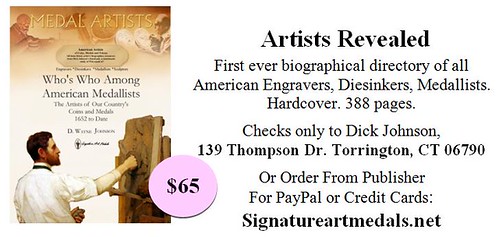
ARTICLE HIGHLIGHTS AIR-TITE COIN HOLDER COMPANY
 Mark Therrien was the only member of his family that collected coins.
Mark Therrien was the only member of his family that collected coins.
His father, Norman, liked to invent things. One day Mark showed his father his coin collection. His interest piqued, Norman bought a bunch of coin holders to protect them.
When Norman's father, who lived nearby, came for a visit, Norman showed him the coin holders that he had purchased. He wasn't impressed with the quality. Norman thought he could make a better coin holder.
"And his father said, 'Why don't you?' " Mark's brother, Scott Therrien, recalled. "And, basically as far as I know, that's how the idea was born."
That's how the late Norman Therrien, who spent 33 years at GE Ordnance writing technical manuals for submarines, came up with the blueprint for Air-Tite Holders Inc.
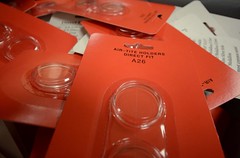 Since then, Air-Tite has been living up to its company slogan: "Quality protection for your collection."
Since then, Air-Tite has been living up to its company slogan: "Quality protection for your collection."
Located at the back of the Robert Hardman Industrial Park on Curran Highway, Air-Tite Holders uses injection molding to make the plastic containers for coins and medallions. Norman Therrien's unique design — a system of holders and rings that fit all sizes of coins — has remained the same since the company's inception in 1980.
Norman Therrien died in 1997, but the company is now co-owned by his sons Scott and Glenn, and their stepmother, Ann Tanner. Mark is a company employee.
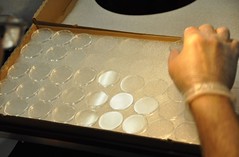 Air-Tite has been at its current location, which contains 22,000 square feet, since 2004. Before moving to North Adams, Air-Tite spent 10
years at the Wyandotte Mill complex in Pittsfield, after being located at five different spots in Dalton.
Air-Tite has been at its current location, which contains 22,000 square feet, since 2004. Before moving to North Adams, Air-Tite spent 10
years at the Wyandotte Mill complex in Pittsfield, after being located at five different spots in Dalton.
None of the owners is exactly sure how Norman came up with the ring system that can hold coins in six standard holders, but it definitely filled a need.
"It's inconceivable to produce molds for every single coin that's been produced, even the U.S. coins from the 1700s and 1800s until now," Scott said. "But my father was able to come up with four sizes of holders. Within these holders, there's a ring that's black or white that has different openings to gauge for coins."
Since the rings can be adjusted to become bigger or smaller, collectors are able to keep several sizes of coins or medallions within the same holder. Air-Tite's smallest model can hold six or seven differently sized coins, Scott said.
And, Air-Tite can produce plastic coin holders to any size, Scott said. "All our holders are basically individuals."
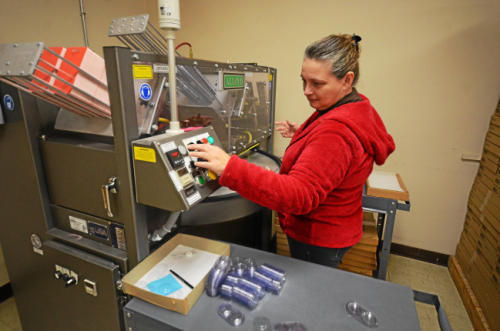
Air-Tite manufactures its holders by molding virgin acrylic plastic that contains a non-yellowing agent, which maintains the clarity of the holders over time.
"A lot of companies make them out of polystyrene, which is a lower grade plastic," Scott said. "It's brittle. It scratches easy, it breaks away, and lots of times it will have a blue or gray hue to the plastic. That's why we wouldn't use polystyrene."
Air-Tite sells mostly to private mints and "fulfillment houses," companies that gather and package products for companies like QVC or the Home Shopping Network.
"If you ever watch coin shows on TV, you'll see a lot of our holders there," Scott said.
The last of the company's original injection molding machines was replaced four years ago. Air-Tite currently has nine state-of-the-art modern machines some of them with robotics capability.
Air-Tite has 14 employees, including the three co-owners. The modern machines have helped the company cut down on costs.
"When we moved into this building, we did two shifts with 26 people," Scott said. "But with the new equipment and the robotics, we're down to what we have now."
Air-Tite also has reduced its energy costs by switching completely to solar power, a project completed a few months ago. The company's 250-kilowatt solar array was installed by U.S. Light and Energy of Latham, N.Y. Last month, Air-Tite paid $28 to the electric company.
To view the complete photo gallery, see:
Photo Gallery | Air-Tite coin
holders keep collections secure (http://photos.berkshireeagle.com/2015/11/20/photos-air-tite-coin-holders-keep-collections-secure/)
To read the complete article, see:
Made In The Berkshires |
Air-Tite: Keeping coins and medallions safe, secure
(www.berkshireeagle.com/business/ci_29145553/made-berkshires-air-tite-keeping-coins-and-medallions)
MORE ON THE 1848 REBUS PUZZLE MEDAL
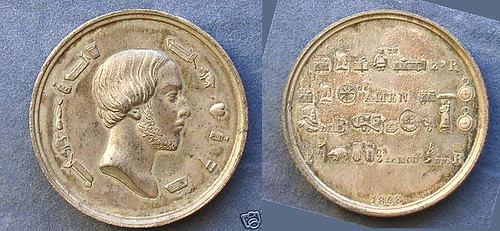
Regarding the 1848 rebus puzzle medal submitted by Philip Mernick, Francois Velde writes:
Regarding the rebus medal, it is in Saulcy but he does not solve the puzzle. See this inumis.com auction lot for a better picture and the answer. It contains praise for the comte de Chambord (grandson of the dethroned Charles X, presented as an alternative to the Second Republic).
To read the complete lot description, see: Lot 1717 - Henri V, médaille rébus -Tous les bras sont ouverts etc-, 1848 Paris (www.inumis.com/vso/henri-v-medaille-rebus-tous-les-bras-sont-ouverts-etc--1848-paris-a42648.html)
Pete Smith writes:
I got bored with rebuses about shoes on old currency. However, show me a French rebus on an old medal and you have my attention. This is my interpretation of the Rebus:
Obverse:
Tout les bras sont ouverts tout les coeurs sont a toi
Reverse:
La Republique blanche enfante la misere
La Republic rouge amene la terreur
Henry IV le Bearnais des Frances fit le Bonheur
En nous leguant son filsle modele du pere
Since there may be some E-Sylum readers who don't speak French, I offer this translation:
Obverse:
All our heart and arms are open to you
Reverse:
The White Republic begets misery
The Red Republic brings terror
Henry IV of the Bearnais Frances brought Happiness
Bequeathing us his model of the father
This was much easier than identifying a painting recovered by the Monuments Men that was not recovered by the Monuments Men.
Scott Miller writes:
The rebus medal is listed in Catalogue Général Illustré des Éditions de la Monnaie de Paris. volume 2 De la 1ere à la 3e République, p. 169 I
Dated to 1848, it depicts the Comte de Chambered on the obverse with the legend TOUS. LES . BRAS. SONT. OUVERTS. TOUS. LES CŒURS. SONT. A. TOI.
The reverse reads LA RÉPUBLIQUE. BLANCHE. ENFANTE. LA MISÈRE. / LA RÉPUBLIQUE. ROUGE. AMÈNE. LA. TERREUR. / HENRI. LE. BÉARNAIS. DES. FRANÇAIS. FIT. LE. BONHEUR. / EN. NOUS. LÉGUANT. SON. FILS. LE. MODÈLE. DU. PÈRE
David T. Alexander writes:
I was delighted to stumble upon Brother Mernick's 1848 rebus medal in the last E-Sylum. It is indeed as medal of the revolutions (plural) of February-June 1848 and portrays the Legitimist pretender to the French throne, Henri V, otherwise the "Child of the Miracle," Duc de Bordeaux or Comte de Chambord (1824-1883). Grandson of King Charles X, last ruling king of the senior line of the House of Bourbon, Henri was born after the assassination of his father the Duc de Berri by republican fanatic Louvel.
The birth was greeted with wild enthusiasm, even by those who did not warmly support the king.
Henri went into exile with his grandfather in 1830 but maintained a lively claim against his usurping cousin "Citizen King" Louis Philippe, against the Second Republic, Napoleon III and the Third Republic. He was actually offered the crown by the National Assembly of the infant Third Republic, which had a monarchist majority. The childless Henri was to adopt his rival the Comte de Paris and accept the Tricolor flag. At the last minute he rejected the deal and returned to exile, dying in 1883. This almost insane act of principle was recalled on as medal commemorating his death with the epitaph, "He was not only a great King, HE WAS AN HONEST MAN!:
However that may have been, the 1848 rebus translates as follows: Obverse:
"Toutes les bras sont ouverts, tous les coers sont a Toi, All Arms are open to You, all hearts are yours." Reverse:
"La Republique blanche, enfant de la misere, la Republique rouge amene la terreur; Henri le Bearnais des Francais fit la bonheur, en
nous leguant son fils le modele du Pere." he White (bourgeoise) Republic is the Child of Misery, the Red Republic the Friend of
Terror; Henri the Bearnais of the French brings good fortune, in us, his sons find the model father."
DeSaulcy plate 60, 5, sculptor Raymond Gayrard. This medal is still struck by the Paris Mint; my 41mm, 36.03 gram example with flying-A privy mark was purchased in 1975 via the Bulletin of the Club Francais de la Medaille while I was on the staff of Coin World and World Coins magazine.
Scott Miller adds:
A similar piece was included in a Heritage sale, ex- Robert Myers. I actually remember when Bob bought that medal. He was very pleased with it and sent me a photo.


To view the complete lot description, see: France: Bronze Medals of Pretender Henri V, Comte de Chambord.... (http://coins.ha.com/itm/france/france-bronze-medals-of-pretender-henri-v-comte-de-chambord-total-5-medals-/a/231317-64033.s)
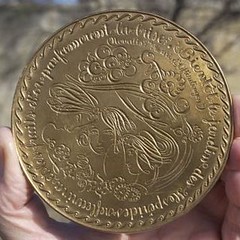

This medal has been minted in 1978 as a REBUS.
This medal has been designed by the French medalist, Marcel JEAN.
av. Rebus; AU SEUILDE L’AN NEUF AGREE (AGREEZ) MES VŒUX, os œeil 2 Laon 9 agres (gree) M’Eve œufs (cinq serres).
rv. Autre rebus; MEILLEURS SOUHAITS, “Mai” HEURES sous Haie.
In exergue; REBUS DE NOËL ET DE NOUVEL AN, raie buse 2 NO-aile e NOU / NOU v’elan.
diameter – 100 mm (3¼“)
weight – 397.50 gr, (14.02 oz)
metal – bronze, GILDED
To read the complete lot description, see:
France, Rebus medal by Marcel Jean, 100mm (www.ebay.com/itm/401014462770)
France, Rebus medal by Marcel Jean, 100mm (www.ebay.co.uk/itm/401014462770)
To read the earlier E-Sylum article, see:
REBUS PUZZLE ON 1848 MEDAL (www.coinbooks.org/esylum_v18n46a17.html)

A HALF CENTURY OF MEDALLIC OBJECTS
Not often is a new class of numismatic items born. We have seen this only twice in the last fifty years. The most recent is the bullion item – coins and medals struck solely for their precious metal content.
December 2015 is the fiftieth anniversary of the other, an entirely new numismatic genre that has swept the world for its popularity among medallic artists. This class of medals is unique to the numismatic field – the medallic object.
Created in the art world, but produced in the medal world, it was a marriage that occurred among three New York City institutions. Not an accident, it was a concept created by an art magazine, an art museum curator, and an art medal manufacturer. For medallic objects are an art creation, the mating of modern art with medallic form.
As a Christmas gift promotion in 1965, Art in America magazine wanted to offer its readers something available nowhere else. Their relationship with the leading artists of the time prompted them to promote a new format bas-relief created by top sculptors, yet in a size suitable for intimate display.
The magazine’s officials commissioned a curator of modern art at New York’s Whitney Museum, Edward Albert Bryant, to manage the project. He contacted the most prominent sculptors in the modern art field. Seven accepted his challenge – to create a modern art work that could be made in a small size.
 The variety of their creations expressed their current work. Sculptor Ernest Trova, for example, was at the time creating a series of major
sculptures in a series best described as “Falling Man.” How to transfer this concept to a smaller venue?
The variety of their creations expressed their current work. Sculptor Ernest Trova, for example, was at the time creating a series of major
sculptures in a series best described as “Falling Man.” How to transfer this concept to a smaller venue?
Trova solved this with a brilliant design of seven human figures aligned inside a circle with a bright red enameled arrow pointing with a subtle thrust of a Man in downwards motion — no matter how the piece was rotated. He added a legend in a raised panel circumscribing the rim.
His design met the form of a medal but was unlike anything ever produced before. It was the birth of a new sculptural work in medallic form, embracing modern art in a new class of numismatic items. A class that was to remain unnamed for two decades.
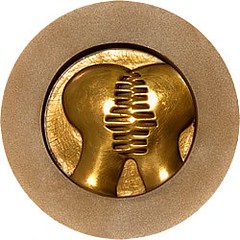 Six other sculptors created models where their imagination and mannerisms ran unfettered. Boston sculptor Harold Tovish interspersed two
human heads he called Meshed Faces. His anepigraphic design denoted a dehumanization of our modern culture with mechanical forms.
Six other sculptors created models where their imagination and mannerisms ran unfettered. Boston sculptor Harold Tovish interspersed two
human heads he called Meshed Faces. His anepigraphic design denoted a dehumanization of our modern culture with mechanical forms.
To read the complete article, see:
Half Century of Medallic Objects
(https://medalblog.wordpress.com/2015/11/17/half-century-of-medallic-objects/)
JULIAN'S SATIRICAL DEFENSE MEDAL
Web site visitor Sunny Carrassi writes:
I just read your article about the Satirical Defense Medal # 4 . I am in possession of the medal and I also have the paperwork. The medal belonged to my late husband. If it is possible I would like more information about the medal such as what was the original cost. I’m finding it difficult to find information. I have attached a copy of the paperwork.
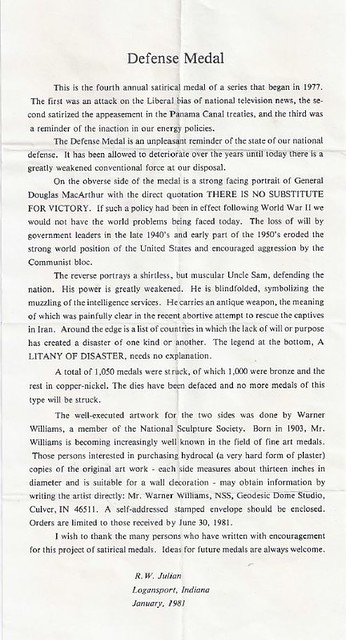
Thanks! In one of our earlier articles the purchase price was listed as $9.95. I reached out to Bob Julian, who writes:
The price quoted, $9.95, is correct and the issue was sold out. The first four medals were advertised at this price but the fifth, and last, was a dollar or two higher because Medallic Art kept increasing their prices. I might note that I did not keep the modest profits, which were donated to the ANA and ANS.
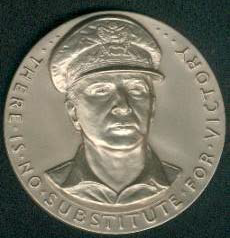
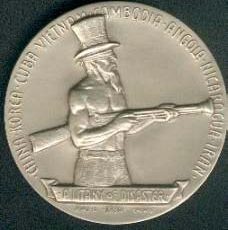
1980 THE DEFENCE MEDAL
RWJ-80 Bronze 63mm Mtg: 1,000 / RWJ-80a
CuNi 63mm Mintage: 50
OBV: “Facing portrait of Gen. Douglas Macarthur with direct quote, ‘There Is No Substitute For Victory’. If the General’s policy had been followed we would not now be facing the problem we do. Loss of will by leaders in the late 1940’s (Dem. Pres. Truman) eroded America’s might and encouraged aggression by Commie Bloc.”
REV: “Uncle Sam, shirtless, blindfolded, armed with antiquated weapon, his power greatly diminished, attempts to defend the nation. The blindfold symbolizes the muzzling of the CIA (Dem. Pres. J. Carter).”
To read the August 2006 MCA Advisory issue, see: www.medalcollectors.org/pdf/the%20mca%20advisory%20august%202006.pdf
To read the earlier E-Sylum articles, see:
JULIAN'S POLITICAL/SATIRICAL MEDALS
(www.coinbooks.org/esylum_v07n20a16.html)
THE POLITICAL SATIRE MEDALS OF R.W. JULIAN 1977-1981
(www.coinbooks.org/esylum_v15n40a19.html)
MORE ON R.W. JULIAN AND HIS POLITICAL SATIRE MEDALS
(www.coinbooks.org/esylum_v15n41a14.html)
THE BOOK BAZARRE
QUERY: JOSEPH WHARTON MEDAL INFORMATION SOUGHT
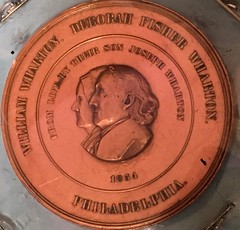

New subscriber Sam Winikor (swinikor@gmail.com) writes:
I recently picked up a medal supposedly made by Joseph Wharton (founder of the Wharton business school at Penn) for his mother and father, Deborah and William Wharton. I cannot find any information regarding this medal. Was it actually made by Joseph Wharton himself? How many did he make? Etc. Would you have any insight or can you help me in finding out the history and rarity of this medal?

'TOENAIL HOARD' OF 500 COIN CLIPPINGS FOUND
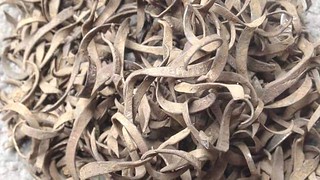 Hundreds of 16th Century coin clippings have been discovered in a Gloucestershire field.
Hundreds of 16th Century coin clippings have been discovered in a Gloucestershire field.
The 500 silver clippings, dubbed the Toenail Hoard, were unearthed by Gavin Warren using a metal detector in the Forest of Dean.
Shaved from the edges of coins dating back to 1560, the precious metal would have been melted down and sold.
Finds liaison officer Kurt Adams said: "Forty to 60 clippings is normal - one of this size is very, very rare."
Mr Warren - who unearthed the Yorkley Roman coin hoard in 2012 - said he was testing out a "beginner's metal detector" in a field, when he made the discovery.
"It was about four inches down, all in a big ball - we thought it was pieces of fencing until I spotted the words James I and Elizabeth I," he said.
"There were about 500 clippings - like pig tails - ranging from half crowns right down to pennies, all silver."
With hanging literally too good for those caught clipping the edges off silver coins in the 17th Century, Mr Warren said whoever buried the hoard had been risking their life.
"For women the punishment was being burnt at the stake, for a bloke it was being hung, drawn and quartered," he said.
"It would have been a lot to have been caught with."
Mr Adams, from the Portable Antiquities Scheme, said the hoard, currently being catalogued at the British Museum, was not only "one of the biggest" but a "fantastic bit of social history".
"The earliest clippings date from the reign of Elizabeth I, so 1560s to 1570s, and the latest from 1645," he said.
"It showed people were defrauding the Mint when it was enormously important that coins weren't tampered with in any way - so it's an incredibly rare find."
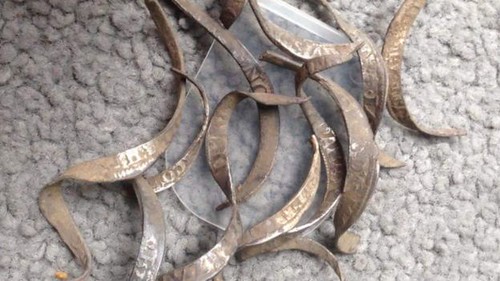
Although this is the first clipping find I recall, only its size makes this hoard uncommon - as noted in the article, most such finds are smaller. I will quibble with the "defrauding the Mint" statement - the clippers were defrauding the next holders of the coins, who were not getting the full weight in silver.
SO... if these hoards are not uncommon, have such clippings found their way into collections? Do any of our readers have any? -Editor
To read the complete article, see:
'Toenail Hoard' of 500 coin clippings found in Forest of
Dean (www.bbc.com/news/uk-england-gloucestershire-34779378)
DNW OFFERS WARD COLLECTION OF BRITISH TOKENS
 The second portion of Ron Ward’s British Tokens will be sold in London on December 7, 2015 by Dix Noonan Webb in their catalogue, “Coins,
Tokens, Historical Medals & Paper Money”. This catalogue can be viewed online at: www.dnw.co.uk
The second portion of Ron Ward’s British Tokens will be sold in London on December 7, 2015 by Dix Noonan Webb in their catalogue, “Coins,
Tokens, Historical Medals & Paper Money”. This catalogue can be viewed online at: www.dnw.co.uk
Ron Ward collected British tokens for over 50 years. Eighteenth and early 19th century copper tokens were sold by Stack’s several years
ago. His “Unofficial Farthings” (500+) were sold by DNW in 2014. The remaining tokens, largely Victorian copper tokens, will be auctioned
in about 50 lots by DNW next month.

Lot 325
Of particular interest are lots 325—329 with countermarked and engraved issues listed by J. Gavin Scott in his book British Countermarks on Copper & Bronze Coins.
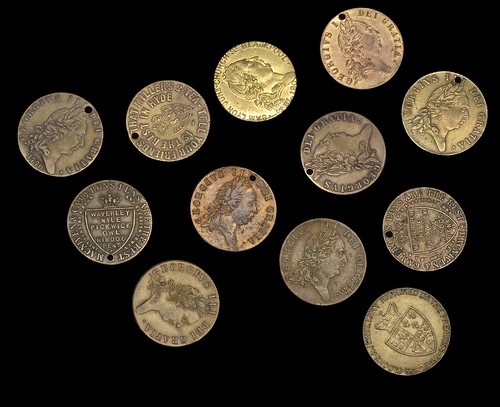
Lot 334
Imitation Spade Guineas are in lots 334-337. Several hundred Merchant Checks are listed (lots 338-348) with a strong emphasis on London. Five lots ( 351-355) of Private tokens as listed by R.C. Bell Tradesmen Tickets and Private Tokens 1785-1819 are of special interest as less than 10 pieces of some are known.
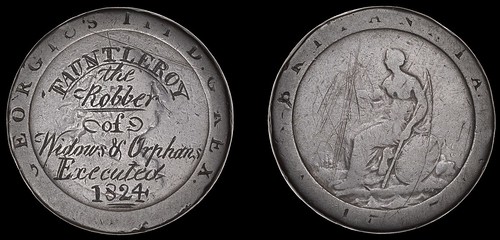
Lot 329
Ron’s favorite token (lot 329) is an engraved George III penny reading: "Fauntleroy the Robber of Widows & Orphans, etc." The catalogue has long write-up about the notorious Fauntleroy. There are illustrations of several hundred tokens which were not shown in many of the standard works on British tokens.
To view the complete catalog, see:
www.dnw.co.uk
CELTIC COINS FROM THE GEOFF COTTAM COLLECTION
Lot 238: Celtic, North Thames, Eastern, uninscribed coinage,
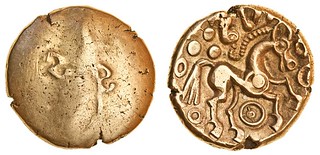
Celtic, North Thames, Eastern, uninscribed coinage, (c.60-20 BC), gold Stater, 5.53g, 'SS' type, two reversed 'S' motifs in field banding beneath, rev. annulate horse right, wing motif above, wheel below, sun before, dispersed symbols in field (ABC 2237; VA 1509-1; S.34), obverse die worn, reverse sharp and well struck, well rounded flan, pleasing, fine/extremely fine, excessively rare
provenance
Bt. Mills, 11 April 1999
Found nr. Norwich, Norfolk
To read the complete lot description, see:
Celtic, North Thames, Eastern, uninscribed coinage,
(www.spink.com/lot-description.aspx?id=15049000238)
Lot 318: Celtic, Trinovantes and Catuvellauni, Tasciovanus, gold Stater
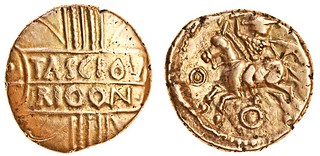
Celtic, Trinovantes and Catuvellauni, Tasciovanus, (c.25 BC-AD 10), gold Stater, 5.46g, 'Tasciov Rigon' type, tasciov above rigon in garnished tablet on vertical wreath, rev. warrior in chain mail riding left, spear and sword in hand, sun wheel below and ring-pellet before (ABC 2577; VA 1780-1; S.219), a little scraping to obverse, struck somewhat off-centre, full legends on this, good detail to horseman, very fine/good very fine, excessively rare
provenance
Bt. Paget, 17 March 2000
Found nr. Milton Keynes, Buckinghamshire
To read the complete lot description, see:
Celtic, Trinovantes and Catuvellauni, Tasciovanus, (c.25 BC-AD 10),
gold Stater (www.spink.com/lot-description.aspx?id=15049000318)
Lot 357: Celtic, Trinovantes and Catuvellauni, Andoco gold Stater
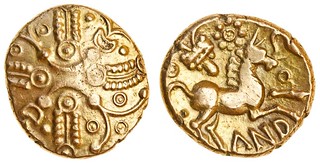
Celtic, Trinovantes and Catuvellauni, Andoco (c.20-1 BC), gold Stater, 5.43g, 'Bucranium' type, crossed wreaths terminating with ring-pellets, opposing crescents in centre of wreath, various symbols in quarters, rev. horse right with garnished bucranium and pelletal sun above, ando below and before, other dispersed symbols, (ABC 2715; VA 1860-1; S.262), Some contact marks and small scratches, weakness in centres, otherwise pleasing with lustre and smooth fields, nearly extremely fine, very rare
provenance
Bt. Mills, 28 December 1995
To read the complete lot description, see:
Celtic, Trinovantes and Catuvellauni, Andoco (c.20-1 BC), gold
Stater (www.spink.com/lot-description.aspx?id=15049000357)
Lot 368: Celtic, Trinovantes and Catuvellauni, Cunobelin gold Stater
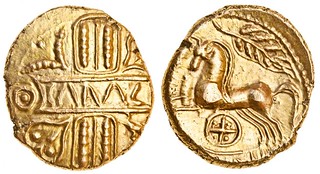
Celtic, Trinovantes and Catuvellauni, Cunobelin, (c.10-40 AD), gold Stater, 5.51g, 'Biga' type, camvl in garnished tablet on vertical wreath, heart-shaped symbols in quarters, rev. biga left, leaf above, wheel and [cvnobelin] below (ABC 2771; Kretz B1, var. 1; VA 1910-2; S.280), struck off-centre, very light wear in remote parts, mostly lustrous with superb fields, essentially extremely fine, very rare
provenance
Bt. Vosper, 30 June 2000
Recorded with the Ashmolean Museum, Oxford, ref. CCI 00.1112
To read the complete lot description, see:
Celtic, Trinovantes and Catuvellauni, Cunobelin, (c.10-40 AD), gold
Stater (/www.spink.com/lot-description.aspx?id=15049000368)
Lot 373: Celtic, Trinovantes and Catuvellauni, Cunobelin gold Stater

Celtic, Trinovantes and Catuvellauni, Cunobelin, (c.10-40 AD), gold Stater, 5.39g, 'Classic' type, garnished corn ear with central stalk flanked by ca mv, rev. Romanized horse right, crescent moon above, cvno on groundline and dotted 'earth' effect below (ABC 2801 - this coin; VA-; S.-), flan slightly irrregularl, small scrape on horse's rump, generally remarkably well presented, good centring both sides, the Romanized horse particularly appealing, nearly extremely fine, an excessively rare piece
provenance
Bt. Dix Noonan Webb, 5 October 2009, lot 5148
Recorded with the Ashmolean Museum, Oxford, ref. CCI 04. 2177
Found nr. Slough, Berkshire
To read the complete lot description, see:
Celtic, Trinovantes and Catuvellauni, Cunobelin, (c.10-40 AD), gold
Stater (www.spink.com/lot-description.aspx?id=15049000373)

SELECTIONS FROM THE SPINK ORDERS & DECORATIONS SALE
Lot 116: Army Large Gold Medal to Lieutenant General Sir George Prevost
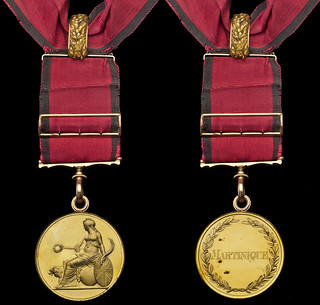
The Historically Important Army Large Gold Medal to Lieutenant General Sir George Prevost, Bt., 'The Defender of Canada' - The Governor General and Commander in Chief of British North America, 1811-1815, Who Was Inextricably Linked to Almost Every Major Action of the War of 1812, And Who 'Arguably, After the Duke of Wellington... Held One of the Most Important Commands in the British Empire During the Napoleonic Period... Sir George Prevost Became Responsible For Defending a Group of North American Colonies that Stretched as Far as Paris Did From Moscow, And He Eventually Commanded One of the Largest Overseas Forces Employed By the British During the Napoleonic Wars' General Officer's Large Army Gold Medal for Martinique (Lieut. Genl. Sir George Prevost.), extremely fine, with all the proper gold suspension fittings and full neck cravat
To read the complete lot description, see:
Army Large Gold Medal to Lieutenant General Sir George Prevost
(www.spink.com/lot-description.aspx?id=15003000116)
Lot 131: East India Company's Medal for Egypt 1801
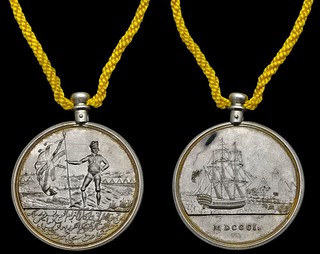
Honourable East India Company's Medal for Egypt 1801, 48mm, silver, a fine quality later striking with die cracks to obverse, nearly extremely fine, with contemporary pillar suspension
Provenance: Spink, April 2009
To read the complete lot description, see:
Honourable East India Company's Medal for Egypt 1801
(www.spink.com/lot-description.aspx?id=15003000131)
Lot 170: Kabul to Kandahar Star 1880
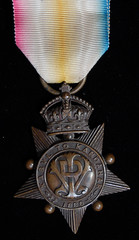 Kabul to Kandahar Star 1880 (Rifleman Chundree Groon 2nd Goorkha Regt.), very fine
Kabul to Kandahar Star 1880 (Rifleman Chundree Groon 2nd Goorkha Regt.), very fine
To read the complete lot description, see:
Kabul to Kandahar Star 1880
(www.spink.com/lot-description.aspx?id=15003000170)
SELECTIONS FROM THE HERITAGE WORLD CURRENCY SALE
Lot 26137: China Russo-Chinese Bank - Tientsin 50 Taels
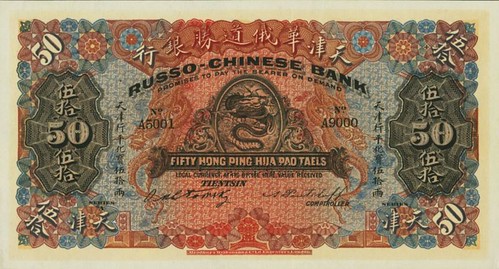
China Russo-Chinese Bank - Tientsin 50 Taels ND (1907) Pick S552s Specimen
The original name for the Russian interest bank appears on this example, with the denomination in taels. This bank later operated as the Russo-Chinese Bank, which used old remainders of this design to print an updated location of issue and denomination in dollars. This update obliterated many features, which can only be seen on a note such as this. The classical design with dragons and the more complex designs in the underprint is a trademark of Bradbury Wilkinson notes only for a few years around the turn of the century.
To read the complete lot description, see:
China
Russo-Chinese Bank - Tientsin 50 Taels ND (1907) Pick S552s Specimen.
(http://currency.ha.com/itm/world-currency/china-russo-chinese-bank-tientsin-50-taels-nd-1907-pick-s552s-specimen/a/3540-26137.s)
Lot 26086: China People's Republic 10 Yuan 1953 Pi

China People's Republic 10 Yuan 1953 Pick 870
The 1953 10 Yuan note is among the most coveted of modern Chinese notes. Attrition was high because of the economic turmoil in the decades after it was issued. As a high denomination, it was far out of the reach of much of the public, amounting to as much as three months worth of labor.
To read the complete lot description, see:
China People's
Republic 10 Yuan 1953 Pick 870.
(http://currency.ha.com/itm/world-currency/china-people-s-republic-10-yuan-1953-pick-870/a/3540-26086.s)
Lot 26221: Macau Banco Nacional Ultramarino 100 Patacas
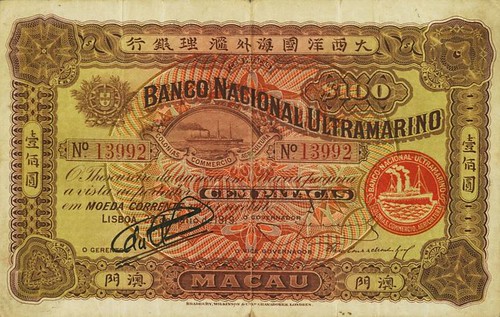
Macau Banco Nacional Ultramarino 100 Patacas 22.7.1919 Pick 9
The crown jewel of Macau banknotes. This was the first 100 Patacas note issued by the BNU and was the highest denomination in circulation until the emergency issues in 1944. The first Patacas were introduced by the Portuguese Colonial government to simplify the multitude of currencies in circulation at that time, from Mexican Pesos to British Trade dollars (Macau was a major trading port). However, circulation of Patacas was not wide, as traders preferred specie or the more recognized and equally valued Hong Kong Dollar. Like early Hong Kong notes, large banknotes were often redeemed at the banks, leading to the scarcity of these notes today.
This stunning example is highlighted by its stainless paper and multicolor underprint as prepared by Bradbury Wilkinson and Company.
To read the complete lot description, see:
Macau Banco
Nacional Ultramarino 100 Patacas 22.7.1919 Pick 9.
(http://currency.ha.com/itm/world-currency/macau-banco-nacional-ultramarino-100-patacas-2271919-pick-9/a/3540-26221.s)
Lot 26029: China Bank of China - Shanghai 10 Yuan 1924
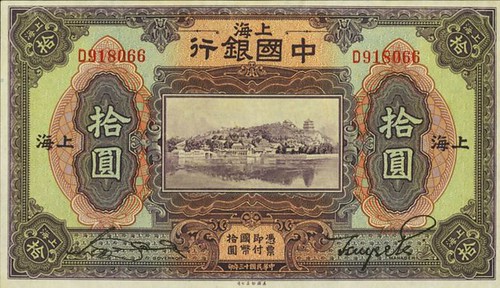
China Bank of China - Shanghai 10 Yuan 1924 Pick 62
An excellent issued version of this design which has only seen the lightest touches of circulation. The complex patterns and colors on the underprint are well preserved on this PMG About Uncirculated 55 example.
To read the complete lot description, see:
China Bank of China -
Shanghai 10 Yuan 1924 Pick 62.
(http://currency.ha.com/itm/world-currency/china-bank-of-china-shanghai-10-yuan-1924-pick-62/a/3540-26029.s)
Lot 26214: Japan US Occupation Kume-jima 50 Sen
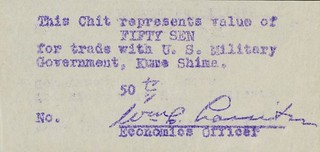
Japan US Occupation World War II - Kume-jima 50 Sen ND (1945) Schwan-Boling 902
A chit printed by the hectograph method and having the facsimile signature of Economics Officer Wm. C. Lassiter. The small island of Kume-jima is in the western part of the Ryukyus, and United States personnel landed there on June 26, 1945. A need to pay local workers quickly developed, and scrip was the answer. Much more detail on this issue can be found on pages 312-13 of World War II Remembered by C. Frederick Schwan and Joseph E. Boling.
To read the complete lot description, see:
Japan
US Occupation World War II - Kume-jima 50 Sen ND (1945) Schwan-Boling 902.
(http://currency.ha.com/itm/world-currency/japan-us-occupation-world-war-ii-kume-jima-50-sen-nd-1945-schwan-boling-902/a/3540-26214.s)
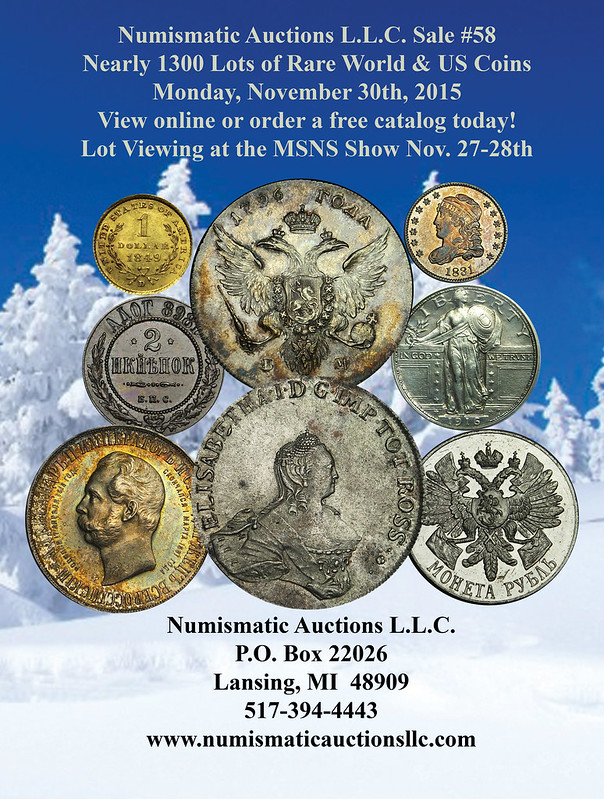
THE KWEICHOW BAMBOO DOLLAR
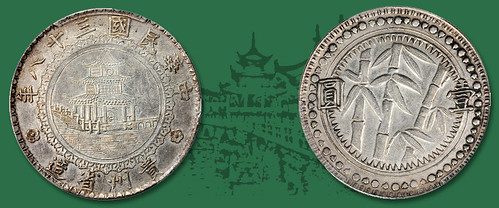
According to Kann, the famous “Bamboo Dollar” from Kweichow province resulted from rampant inflation in the 1940s that devalued paper currency in China leading some provinces to begin minting their own metallic money. Minted in the “38th year of the Republic” (1949) this beautifully designed coin shows an incredible level of artistry and very little circulation.
Part of the reasoning behind the scarcity of this piece is the historical events unfolding around the time period. In late 1945 the Chinese Civil War resumed, with the communist forces controlling Beijing and other major Kuomintang cities passing to Communist control. As these were minted during this tumultuous period (under the Republican government) these coins were often buried (leading to often seen corrosion on this issue), hidden away in stashes (providing excellent collectible examples) or simply destroyed by the communist government and repurposed. As such, this coinage type from the twilight of the mainland Republic of China is exceedingly scarce and stands among classic Chinese numismatic treasures.
The obverse design features a stunning image of an iconic three story Chinese pavilion known by the name Jiaxiu Tower (First Scholar’s Tower). The name Jiaxiu hails from the Ming dynasty era when the tower was built and means “getting the very best in Imperial examinations.” The building was provided as a place to live study for these “number one scholars,” and records indicate that three such officials have honored the city by residing there. Standing at 66 feet high the tower is adorned with green tiles, red pillars, artistically engraved windows and stunning white stone parapets.
The initials “TLK” appear just below the door of the pavilion and are speculated to refer to the engraver of the coin. Two varieties exist for this “Bamboo Dollar,” identified by the window in the top story, with this being the “round window” variety. A wonderfully ornate border surrounds the Jiaxiu Tower on bridge design, with descriptive legends around. The upper legend states: “38th Year of the Republic of China” which means the year 1949. Beautiful rosettes separate the upper legend from the lower legend: “Made in Kweichow Province.”
The reverse design offers this coin its informal title of “Bamboo Dollar”; three stems of bamboo with leaves are encompassed by a saw-tooth border, followed by a beaded border and finally a crenulated outer border. The Chinese characters for “One Dollar” appear at either side of the Bamboo image. This example is tied with two other examples at this grade level with only three pieces certified finer by either PCGS or NGC.
Look for this and other world numismatic rarities in our upcoming December Hong Kong Showcase Auction.
To read the complete lot description, see:
CHINA. Kweichow. Dollar,
ND (1949). PCGS AU-50 Secure Holder. (www.stacksbowers.com/BrowseAuctions/LotDetail/tabid/
227/Lot/60176/AuctionID/6115/Default.aspx)
To read the complete article, see:
Exceptional
High Grade Kweichow Bamboo Dollar (www.stacksbowers.com/NewsMedia/Blogs/TabId/780/ArtMID/
2678/ArticleID/65465/Exceptional-High-Grade-Kweichow-Bamboo-Dollar.aspx)
THE LATVIA FIVE CATS FIVE EURO COIN
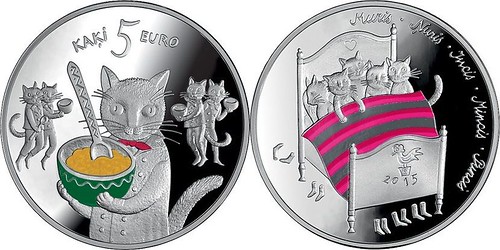
Pabitra Saha writes:
There is a children's book titled "pieci kaki" ( five cats) by Albert Kronenberg. It has stories based on 5 cats and was released in 2014 and became very popular. The coin commemorates that folk tales book. This is what Bank of Latvia has to say:
"The obverse of the coin features a bed with five sleeping cats. The bed-foot is decorated with an image and the inscription 2015. The names of five cats – Muris, Ņuris, Incis, Mincis and Puncis – are arranged in a semi-circle on the right.
"A cat holding a porridge bowl is placed in the centre. Cats with smaller bowls and spoons are featured on either side of the central motif. The words KAĶI (CATS) and EURO, with the inscription of the coin's value and cats' number "5" in between them, are placed at the top. (Reverse)"
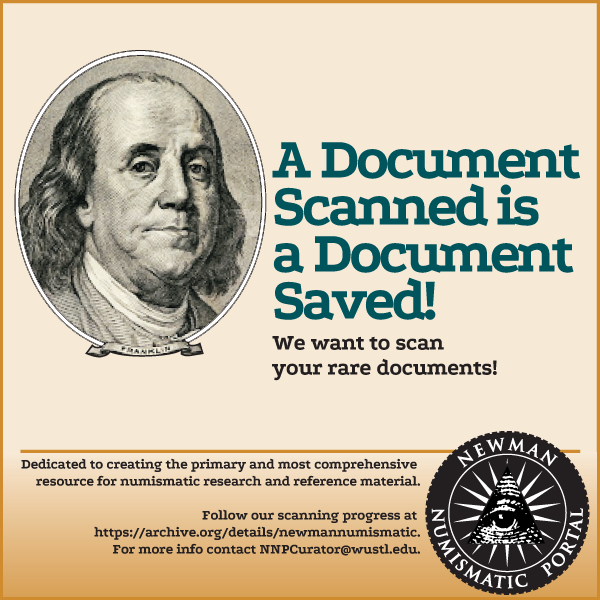
THE SESTERTIUS OF AGRIPPINA SENIOR
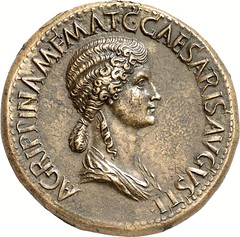
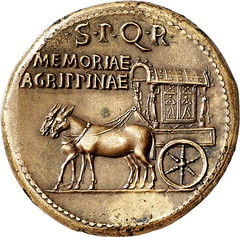
This Sestertius coin was a lone piece amongst 200 of the world’s finest Greek & Roman in an Auction at Sotheby’s in the 1995; time has made me forget the full story of who told me about the item. I do remember visiting London and meeting Tom Eden specially to see it; if one can ‘love’ a coin at first site then I was bewitched by the brass Sestertius. I was to have it at any price, the ageless portrait smiled at me from the coin, she was beautiful and dignified and I had not realized that such a piece existed with such beauty.
An embarrassing story of total irresponsible action of any human being to mortgage to acquire a coin. Prior to the sale I deposited the deeds of our house to get a loan. We acquired the coin for which I had a large pictures on the wall in my study for many years, she is as beautiful as the day I met her. The donkeys with such minute details.
There are coins that I enjoy for the perfect quality and those that are a “work of art”; a few are ‘masterpieces’. I am asked what you mean by a ‘masterpiece’, ask ten people and get ten answers; everybody has his own opinion of what is a ‘masterpiece’. I am spending a lot of time considering this point. Is it were the artist has detached himself to create a piece of art that will last for time memoriam.
To read the complete article, see:
Roman Coin Profile – Sestertius of
Agrippina Senior (www.coinweek.com/ancient-coins/roman-coin-profile-sestertius-of-agrippina-senior/)
ROMAN COIN HOARD FOUND IN SWITZERLAND
 The stash of more than 4,000 bronze and silver coins is believed to have been buried some 1,700 years ago.
The stash of more than 4,000 bronze and silver coins is believed to have been buried some 1,700 years ago.
Weighing around 15kg (33lb), he discovered the coins after spotting something shimmering in a molehill.
The regional archaeological service said the coin trove was one of the biggest such finds in Swiss history.
The trove was unearthed in July in Ueken in the northern canton of Aargau.
Since a Roman settlement was discovered in the nearby town of Frick, just a few months before, he suspected the coins might be of Roman origin.
The farmer contacted the regional archaeological service who, after months of careful excavation, announced on Thursday that 4,166 coins had been found in excellent condition.
Some of the coins date from AD 274 and the rule of Emperor Aurelian. The find also included coins from the time of Emperor Maximian in 294.
Swiss archaeologist Georg Matter, who worked on the excavation, said what they found within the first three days "exceeded all expectations by far".
To read the complete BBC article, see:
Trove of ancient Roman coins found in Switzerland
(www.bbc.com/news/world-europe-34872657)
To read the complete article in German, see:
Spektakulärer
Fund: Aargauer Bauer stösst auf römischen Münzschatz
(www.aargauerzeitung.ch/aargau/fricktal/spektakulaerer-fund-aargauer-bauer-stoesst-auf-roemischen-muenzschatz-129745544)
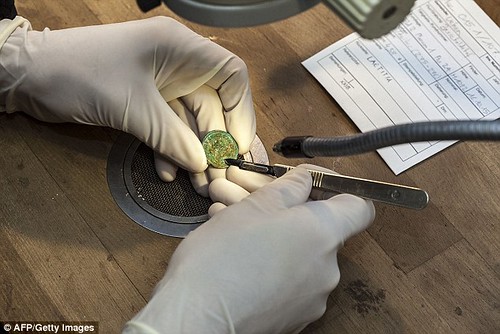
To read the complete article, see:
In the money! Massive hoard of 4,000 Roman coins unearthed in Switzerland after lying undisturbed under a cherry tree for 1,700 years
(www.dailymail.co.uk/sciencetech/article-3326915/Hoard-4-000-Roman-coins-unearthed-Money-laid-undisturbed-beneath-Swiss-cherry-tree-1-700-years.html)

THE PURCHASING POWER OF ANCIENT COINS
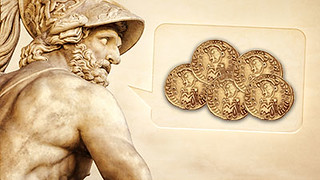 ONE OF THE MOST frequently asked questions that classical numismatists encounter is “What was this ancient coin worth back then?”
ONE OF THE MOST frequently asked questions that classical numismatists encounter is “What was this ancient coin worth back then?”
A meaningful answer must usually begin: “It’s complicated.” A more complete answer might include “It depends…”
In our global economy, where almost everything is instantly convertible into cash, we can state precise exchange rates: one US dollar is worth 0.87 euro or 0.95 Swiss francs, or 0.65 British pounds. But what is today’s value of a US dollar in terms of ancient Athenian drachmai, or ancient Roman sestertii? When an ancient Roman had a silver denarius in his purse, what could he buy with it? Ancient economies did not work like modern ones, and ancient writers, almost all slave-owning aristocrats who belonged to privileged elites, rarely wrote about the vulgar topic of money.
Bullion Equivalent Value
Ancient coins, like medals in the modern Olympic games, come in gold, silver and bronze. Can’t we simply express equivalent ancient and
modern values in terms of precious metal? Gold closed this week at US$1,142 per Troy ounce[4], so a 7.0-gram ancient Greek gold stater from
the time of Alexander the Great (died 323 BCE) represents a bullion value of $262.87. An 8.18-gram Roman gold aureus from the time of
Julius Caesar (died 44 BCE) would contain gold worth $307.18.
But “bullion equivalent value” is a very shaky basis for comparing buying power across the centuries. We are comparing gold that was mined with slave labor and refined in charcoal-fired furnaces to gold that is mined with huge diesel-powered shovels and refined with modern physical and chemical methods. In the ancient world, copper alloys (bronze and brass) formed tools, weapons, statues, cooking vessels and countless other non-coinage uses. In our world, copper is a commodity used mainly for electric wiring.
Labor Equivalent Value
We know from many sources that a silver drachma or denarius was a typical day’s minimum wage for a manual worker. Taking today’s US$7.25
minimum hourly wage for comparison, a day’s labor would be worth $58. Keep in mind that when we compare labor equivalent values across the
centuries, we are comparing an ancient world where muscle power was a primary energy source, to a modern world largely powered by engines,
motors and data networks. In our world a small and diminishing number of farmers can each feed themselves and over 50 others. In the
ancient world, most workers were farmers and they struggled to feed themselves and a few others.
Soldier’s Pay
Another way of thinking about labor equivalent is soldier’s pay – one of the most important items in the budget of ancient empires. In the
fourth century BCE, Greek hoplites (armored infantry) typically received a drachma per day (sometimes supplemented by another
drachma to pay for a servant while on campaign). Computed as an annual salary, this represents about 1,540 grams of silver or, converted
into gold at the typical ancient 15:1 rate, 103 g of gold (about three-and-a-third troy ounces).
Now consider a modern soldier’s pay. A US Army E-2 with less than two years service earns a base pay of $20,808. That would buy over 40 kilograms of silver, or about 555 grams (18.2 troy ounces) of gold at current rates. So in terms of the gold standard, Americans value a foot soldier more than five times as highly as ancient Greeks, and more than eight times as much as ancient Romans did.
Summary
Ancient economies were largely “bimetallic.” Elites used gold coin, for purchases of luxury goods, property, and slaves. Silver coin
typically circulated for the payment of wages, and bronze token coinage circulated for the purchase of daily necessities. At the risk of
oversimplification, we can think of a small copper as the price of a loaf of bread, a pure silver coins as a worker’s daily wage, and a
gold coin as the price of a good horse.
Modern currency is primarily “fiat money”, with a value determined by government, while ancient money was largely “commodity money”, with values determined by the supply and demand of precious metals.
To read the complete article, see:
What Were They Worth? The Purchasing Power of Ancient
Coins (www.coinweek.com/education/worth-purchasing-power-ancient-coins/)
SOUTH FLORIDA ARTIST CONVICTED OF COUNTERFEITING
United States Attorney A. Lee Bentley, III announces that a federal jury has found Jean Phineas Losier (41, Wellington) guilty of conspiracy to deal in counterfeit Federal Reserve notes. He faces up to five years in federal prison. A sentencing date has not yet been set.
According to the trial testimony and court documents, Losier began manufacturing a specific United States counterfeit note (designated by the United States Secret Service as D23548 and D23548A) in 2008. Over the ensuing years, he engaged in a substantial counterfeit relationship with co-defendant Mercury Thompson, and others, to sell and pass the counterfeit $100 and $50 notes. Losier operated alone in the manufacturing process. Using laser printer and toner technology, and an elaborate bleaching and re-printing process, he stripped the ink from genuine $1 bills and then manufactured counterfeit $100 and $50 bills on the remaining paper.
On January 14, 2014, Secret Service agents executed search warrants at a Wellington apartment where Losier had manufactured the notes. The agents seized manufacturing devices and also located bleached genuine $1 Federal Reserve notes, chemicals and chemical residue, as well as other indicators of high volume bleaching. Detailed molds and templates, reflecting the image of genuine United States security watermarks, were located inside the residence. Losier, an artist, had etched the watermark molds.
Forensic analyses of the seized electronic media and counterfeit notes revealed Losier’s detailed manufacturing process, including images of the notes at virtually every stage of the manufacturing process. Investigators were able to forensically match the electronic devices to counterfeit $100 bills seized at various stores in the Jacksonville area during April and May 2010, including bills seized from the St. Johns Towns Center. The forensic comparison of the images also matched $4,200 of counterfeit $100 notes seized from a rental vehicle in which Thompson was present on July 12, 2012, and $10,000 in $100 counterfeit notes that another individual purchased from Losier on January 10, 2014.
According to Secret Service forensic examiners, the value of the known counterfeit notes (D23548 and D23548A) passed in the Southern and Middle Districts of Florida since late 2008 is more than $3.5 million. The known amount passed worldwide exceeds $4.3 million. After Losier’s arrest on January 14, 2014, the passing of these designated counterfeit notes ceased almost entirely.
To read the complete article, see:
Jury Convicts
South Florida Artist In $4 Million Counterfeit Currency Conspiracy
(www.justice.gov/usao-mdfl/pr/jury-convicts-south-florida-artist-4-million-counterfeit-currency-conspiracy)

When Jean Losier wasn't creating paintings and sculptures for clients at his South Florida studio, prosecutors say he was churning out more than $US4.5 million ($6 million) worth of counterfeit $50 and $100 bills at his home.
Demand was so great for his fake currency that the ink on some of the notes seized by federal agents was still damp and some of the notes were stuck together.
His website describes him as a mega-artist born in 1974; "in the illustrious country of Port Au Prince, Haiti" who "migrated to the promise land of the United States of America as a youth".
It says he is a prolific artist of elite drawings, paintings and sculptures, whose work has been exhibited widely and featured in the movie My Best Friend's Wedding in partnership with another Florida artist.
Losier was born in Haiti but moved to the US when he was three; it is likely he will be deported after he serves his prison sentence.
To read the complete article, see:
Florida
artist who produced more than $US4.5 million in counterfeit money pleads guilty
(www.smh.com.au/world/florida-artist-who-produced-more-than-us45-million-in-counterfeit-money-pleads-guilty-20151106-gksiwq.html)
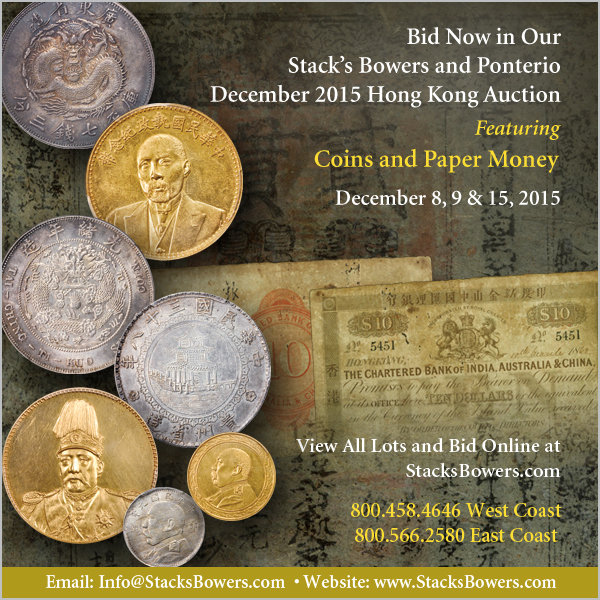
MOY: BITCOIN ALLOWS MONEY TO BE PRIVATIZED
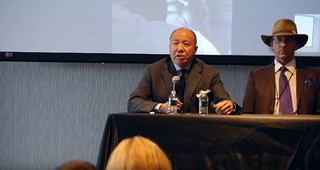 Former Director of the United States Mint Edmund C. Moy was featured on a panel during the recent Bitcoin Investor Conference in Las Vegas,
and he shared an unique perspective on bitcoin for someone who was once a government official under the Bush and Obama administrations. Unlike most
individuals involved in government who focus on monetary policy, economics, or the creation of fiat currency, Ed Moy enjoys the privatized nature of
bitcoin as a potential currency. Moy sees Bitcoin as a technology that could bring back the days of a democratized money that is held in the hands of
the people.
Former Director of the United States Mint Edmund C. Moy was featured on a panel during the recent Bitcoin Investor Conference in Las Vegas,
and he shared an unique perspective on bitcoin for someone who was once a government official under the Bush and Obama administrations. Unlike most
individuals involved in government who focus on monetary policy, economics, or the creation of fiat currency, Ed Moy enjoys the privatized nature of
bitcoin as a potential currency. Moy sees Bitcoin as a technology that could bring back the days of a democratized money that is held in the hands of
the people.
Money Used to Be in Private Hands
During Ed Moy’s comments at the Bitcoin Investor Conference, it became clear that he’s a fan of privately-held money. At one point, he
described the democratized nature of money thousands of years ago:
“[One] reason why I like cryptocurrencies and where my mind has gone on all this is that when you take a look at our earliest notions of money — money was in private hands. You found electrum, which is basically a mixture of gold and silver in the ground. Sizes were important, and if you just pounded it into a mold — and you use that in trade, so money was very — it was in private hands, it was the ultimate democratization of money.”
Old Money Had Its Problems
Of course, there are a few issues with using chunks of electrum as money. Moy explained some of these problems during his remarks on
privately held money:
“That limited economic growth because you had this issue of standards, weights, [and[ measures, so electrum — when you find it in the ground — it could be 90 percent gold and 10 percent silver, 92 percent, [or] 94 percent. You wouldn’t know. You might get the weight right, but if you didn’t get that purity right, you had a problem. And then, as commerce got bigger and bigger and transactions got bigger and bigger, you needed more coins, and the technology would not allow the private sector to keep up with demand.”
Governments Tried to Solve Those Issues
Due to the fungibility issues related to old forms of money, governments stepped in to create common currencies that were easily
recognizable. Moy briefly mentioned the positive effect this had on trade:
“Government stepped in, and the big step was in Lydia where they figured out how to purify gold. And once they purified gold, you already had weights and measures down, and all of the sudden things started clicking.”
When you have something like a coin made up of a single precious metal, it becomes easier to verify the authenticity of the money and understand its value.
Bitcoin Can Privatize Money Again
Of course, with bitcoin, there is no need to create a uniform coin that is easily recognizable to the general public. A bitcoin is a
bitcoin, and there are no standard measurements to worry about. There is no need to weigh it every time it is used in a transaction or
store large amounts of it in a vault owned by a third party. Edmund Moy explained that bitcoin could allow money to become privatized once
again:
“Well, I see bitcoin as the improvement in technology that allows money to be privatized again, back where it should be because it is my belief that one of the main uses of money is economic transactions. Why is government involved in economic transactions except for the ability to tax that transaction and get their income out of it? So, if money is primarily used in economic transactions between two people, then it makes a lot of sense to me that — if current technology allows, then money should be privatized because it’s used between two people.”
Moy’s comments during this panel discussion fly in the face of JPMorgan Chase CEO Jamie Dimon’s recent comments on bitcoin. While Dimon could never see governments allowing an uncontrolled currency like bitcoin to prosper, Moy believes it could be the financial technology that brings money back to the private sector.
To read the complete article, see:
Former Director of US
Mint: Bitcoin Allows Money to Be Privatized Again
(http://insidebitcoins.com/news/former-director-of-us-mint-bitcoin-allows-money-to-be-privatized-again/35866)
To read the complete articles, see:
ED MOY'S THOUGHTS ON BITCOIN (www.coinbooks.org/esylum_v17n22a30.html)
FORMER MINT DIRECTOR MOY AT BITCOIN EXPO
(www.coinbooks.org/esylum_v17n27a27.html)
ED MOY ON SAVING BITCOIN FROM THE REGULATORS
(www.coinbooks.org/esylum_v17n29a17.html)
BITWALKING DOLLARS: GET PAID TO WALK
 A digital crypto-currency has launched that is generated by human movement.
A digital crypto-currency has launched that is generated by human movement.
Bitwalking dollars will be earned by walking, unlike other digital currencies such as Bitcoins that are "mined" by computers.
A phone application counts and verifies users' steps, with walkers earning approximately 1 BW$ for about 10,000 steps (about five miles).
Initially, users will be given the chance to spend what they earn in an online store, or trade them for cash.
Japanese electronics giant Murata is working on a wearable wristband that will provide an alternative to carrying a smartphone and show how many BW$ the wearer has earned.
Shoe manufacturers are poised to accept the currency, and a UK high street bank is in talks to partner with the project at one of the UK's biggest music festivals next year.
The founders have a track record in disruptive technology that could help developing nations as much as richer ones.
Last year they launched Keepod, a $7 USB stick that acts like a computer in Nairobi, Kenya.
The idea of Bitwalking is to take advantage of the trend for fitness trackers by offering an additional incentive to keep fit.
The global scheme plans to partner with sportswear brands, health services, health insurance firms, environmental groups, and potentially advertisers who could be offered unique insights into the audiences they are targeting.
In the future, employers may be invited to take part in a scheme that would be offered to their employees to encourage them to stay fitter, with the currency they earn converted and then paid alongside their salaries.
To read the complete article, see:
Bitwalking dollars: Digital currency pays people to walk
(www.bbc.com/news/technology-34872563)
FEATURED WEB PAGE: WORLD COIN GALLERY
This week's Featured Web Page is Don Norris’ WorldCoinGallery.com, suggested by Jeff Starck. Thanks.The Largest Collection of Full Color Coin Images in the World! Gallery Total: Over 60,750 coin photos from 1,270 places. Additional selections: Over 2500 German State coin types from 127 states! Plus over 2300 German Notgeld coin types from 626 places!
http://worldcoingallery.com/

